Hindu famous (authentic) (sacred) pilgrimage sites in India – Part 4
Namaste friends, how are you doing today? Welcome to #BhagavanBhakthi website / blog.
Bhagavan Lord Sri Krishna blessings to you and your family!
In this website / blog, you will always learn about #Hinduism #Sanskrit language.
Also subscribe to my YouTube channel from this link #BhagavanBhakthi to view videos about #Hinduism #Sanskrit language.
Just before moving towards to know about “Hindu famous (authentic) (sacred) pilgrimage sites in India – Part 4“, let us know few basic information.
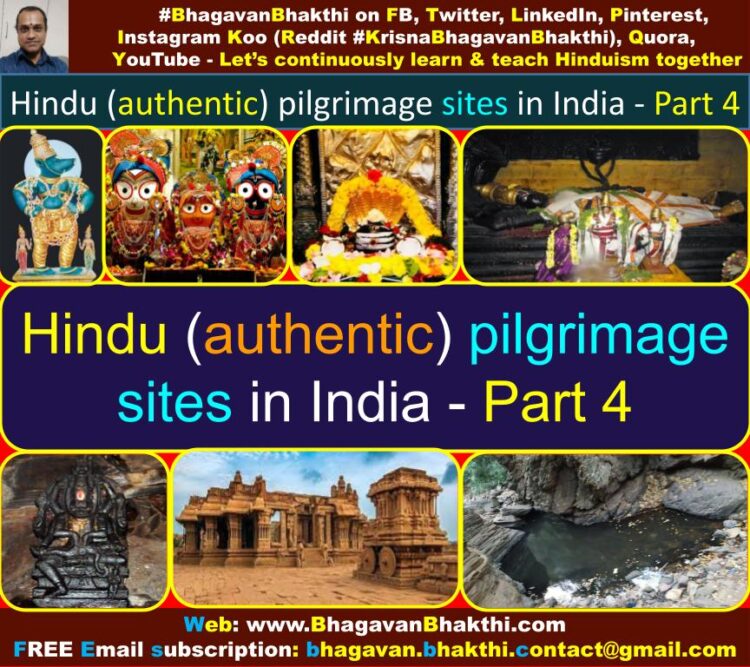
I urge to the readers to read this post completely and also to read the other posts connected with this post, to understand about all the pilgrimage sites of India with authenticity as per Hindu Puranas.
Note : Please note that, as said in the part 1, part 2 and part 3, this below information is based on an authentic grantha (Hindu text) which was written around 500 years ago.
And this is completely free from the today’s Babas, Swamy’s, modern temples, money oriented temples, etc. information.
For few web visitors, these pilgrimage places may look like unknown places.
But, all these places are genuine pilgrimages places as given in Hindu Puranas and other granthas (texts).
There was a great and divine saint (Sanyasi) in Udupi, in South India called as Guru Sri Vadiraja Tirtha nearly 500 years ago.
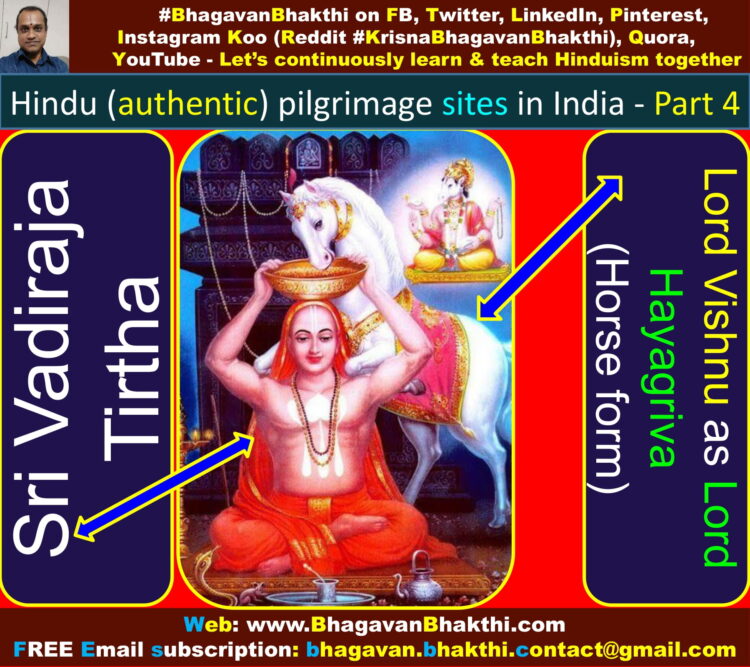
He had travelled all over India and had written a grantha (Hindu text) called as ‘Tirtha Prabandha‘ (pilgrimage places information).
In this grantha (Hindu text), he has given information about the various pilgrimage places around the India.
Guru Sri Vadiraja Tirtha visited the holy pilgrimage sites around India starting from Udupi (Karnataka) in a clockwise direction, through:
West —> North —> East —> Southern directions.
Finally Guru Sri Vadiraja Tirtha reached a place called today’s Thiruvananthapuram and submitted his holy grantha (Hindu text) at the lotus feet of Lord Sri Ananthapadmanabha Swamy in Kerala.
Now, let us know those pilgrimage places basic information.
Let us continue from “Hindu (authentic) pilgrimage sites in India – Part 1, Part 2, Part 3“, that is, let us start from the Purva (Eastern) side from where we left in Part 3 as given below:
Purva Prabanda (India’s Eastern side pilgrimage sites part 4 information) is as given below:
(This covers East-Southern parts of the authentic pilgrimage places of India).
GangaSagar (Sagara) (Sangam) : This is the revered place where the most auspicious river Ganga joins Sagar (Ocean) at today’s Bay of Bengal near Kolkata.
This place is about 150 kms from today’s Kolkata (Calcutta).
The great Sri Madhwacharya mentions in his text called ‘Mahabharata Tatparya Nirnaya‘ (A commentary text on Mahabharata) that –
It was at this very place that Lord Varuna Deva got cursed by Lord Brahma, to take birth as Mahabhishak and Shantanu (Bhishma’s father) for spraying water on him, when he came on for a bath.
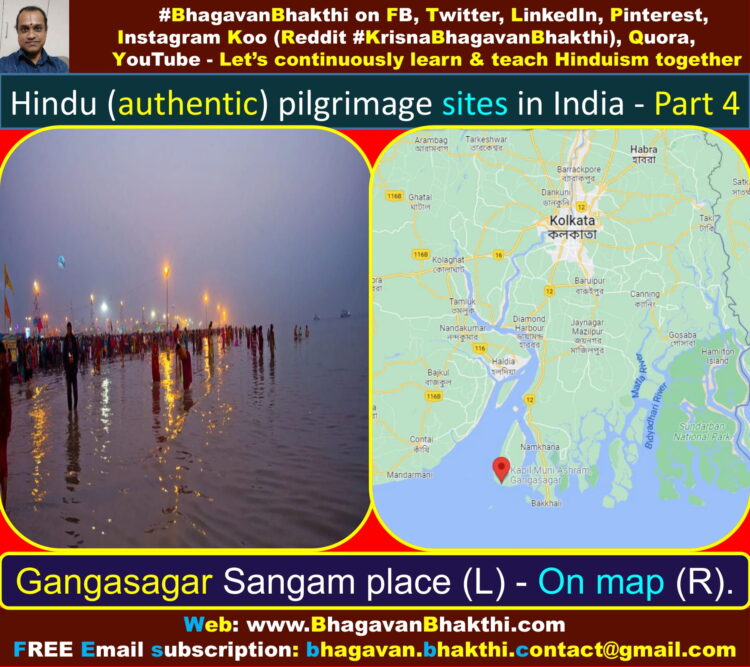
Puri Jagannath (Jagannatha) : In older time, this place was known as ‘Purushottama Kshetra’ (Purushottam Kshetra) and ‘Shankha Kshetra’ (Shankh Kshetra).
Puri was also earlier known as ‘Neelachala’ (Neelachal), where existed temple of ‘Neela Madhava’ (Neel Madhav).
When Neelachala (Neelachal) was submerged under the sea, the celestials took Neela Madhava (Neel Madhav) to heaven.
Later, Indradyumna found holy wood and from which the deities of Lord Krishna (Jagannath), Balarama (Balabhadra) and Subhadra Devi are found and installed here.
Based on the prayer by Devarishi Narada, all these three deities are standing in Puri (Puri Jagannath) in the wooden form.
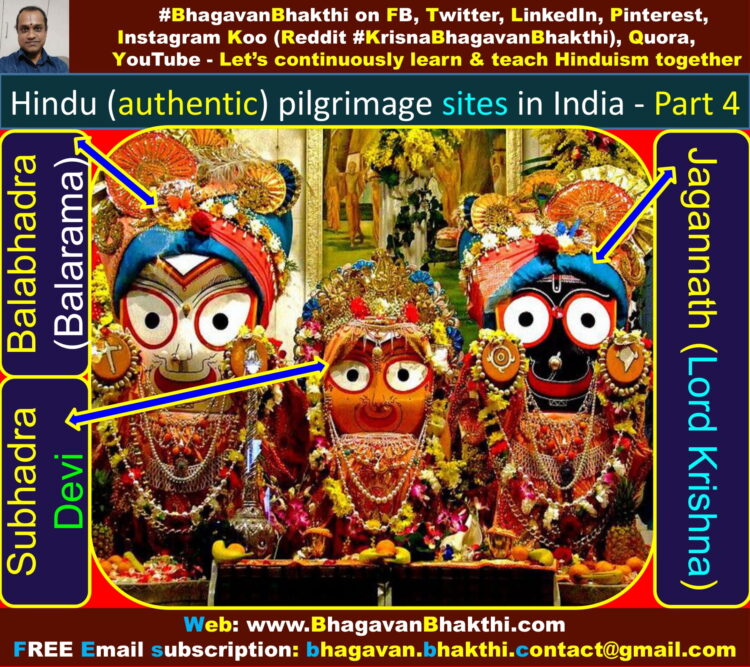
We should note that, Puri (Puri Jagannath) is one of the 4 most popular and famous Kshetras (pilgirmage places) of India.
The other three are Badarinatha (Badrinath) in the north, Rameshwaram in the south and Dwaraka (Dwarka) in the west.
Puri (Puri Jagannath) is about 60 kms from Bhubaneshwar in Odisha.
Guru Sri Vadiraja Tirtha reveals an important siddhanta (theory) here.
The knowledge of tattva-vada (divine truth) i.e. Hari sarvottamatva, that is, the knowledge of Lord Vishnu is Supreme is the most important factor.
Without this knowledge, overall ‘Vaidika jnana’ (Vaidik gyan) (Vaidik knowledge) is of no use.
This is just like how without the shaft, the blade of an axe can never achieve its purpose.
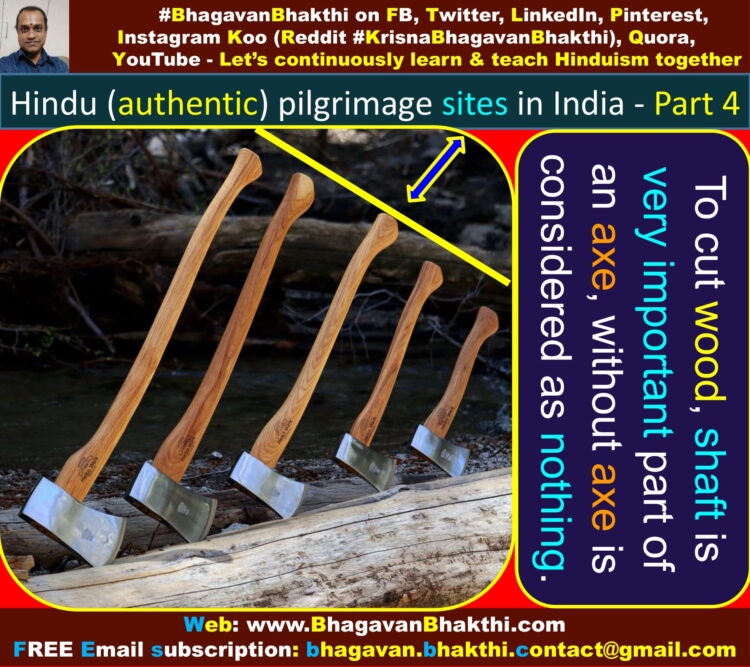
Another example is that, just as how the shaft of an axe, although made of wood itself, is used to cut wood.
Similarly this life of Sansar (Samsara) (from birth to death), is itself to be put to good use, through jnana (gyan) (knowledge).
This is because, to ultimately get out of this very Sansar (Samsara) (from birth to dearth).
Note : We should remember that Sansar (Samsara) is different and Parivar is different.
Sansar (Samsara) means, from the time we take birth and until our death period.
Whereas, Parivar means our whole family, that is, wife, husband, children, parents, relatives etc.
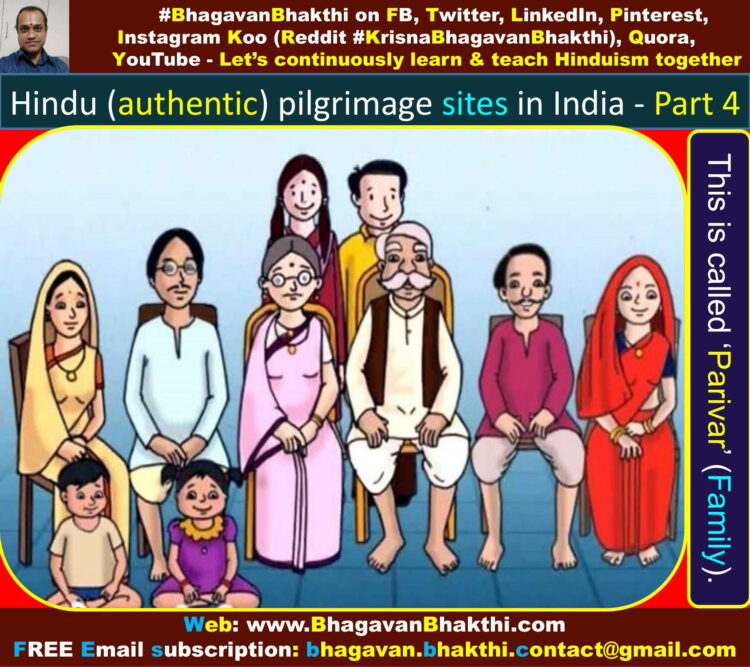
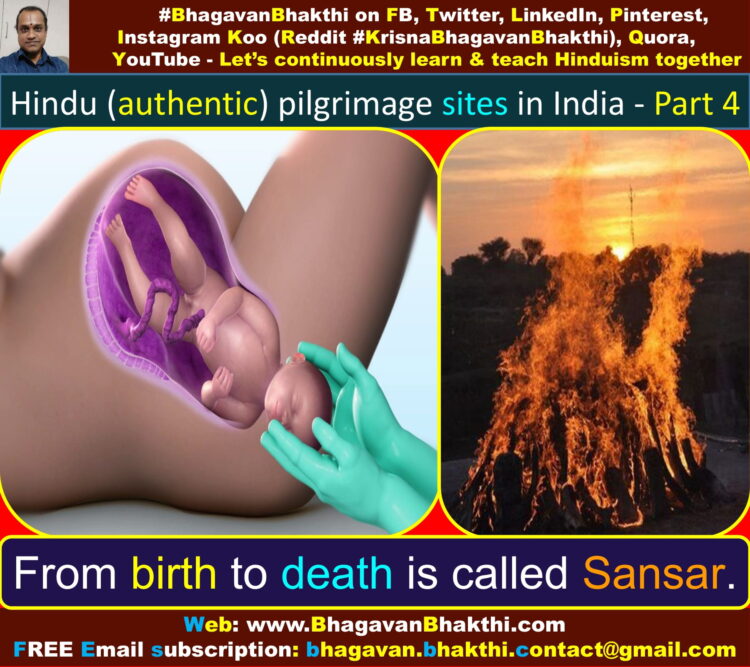
Srisailam (Srishaila) (Srisaila) : Srisailam (Srishaila) (Srisaila) is the abode of Lord Malligarjuna Swamy (Lord Shiva).
The deity of Lord Mallikarjuna gracefully situated on a flat top of Nallamala (Nallamalai) Hills.
It is on the right side of the River Krishna in Kurnool District of today’s Andhra Pradesh.
This celebrated mountain is also named as Siridhan, Srigiri, Sirigiri, Sriparvatam and Srinagam.
Lord Shiva in Srisailam (Srishaila) (Srisaila) is known as ‘Lord Mallikarjuna‘.
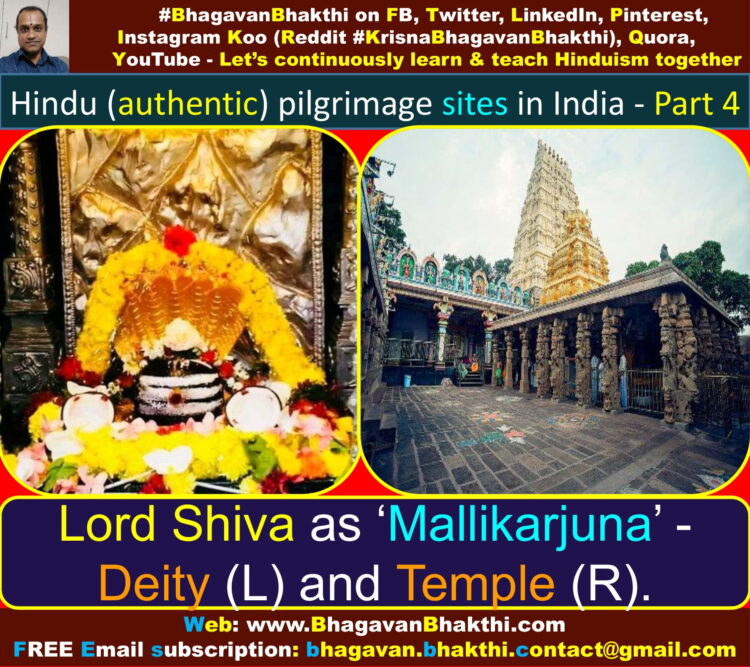
Hence Guru Sri Vadiraja Tirtha explains Lord Mallikarjuna (Shiva) as having the colour of Mallika (Jasmine) flower.
And Goddess Sri Parvati Devi at Srisailam (Srishaila) (Srisaila) is called as Mallika and Lord Shiva is known as Arjuna.
Hence the deity is called as Lord Mallikarjuna.
(Note : As per Hindu text legend, the presiding deity in the form of Linga (Lord Shiva) was –
worshipped with jasmine flower, leading to the name of presiding deity as Lord Mallikarjuna.)
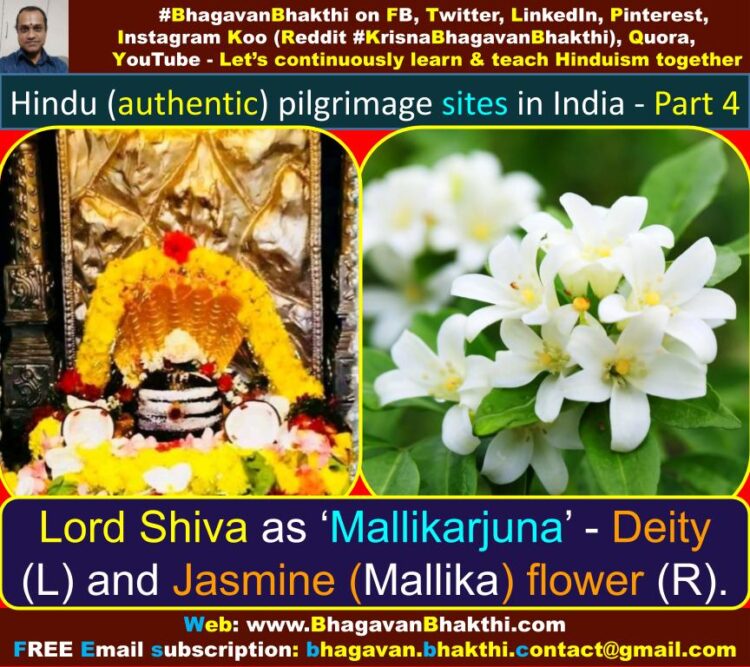
In Sanskrit Mallika means jasmine.
Srisailam (Srishaila) (Srisaila) is located about 200 kms from today’s Hyderabad.
The Lord Shiva Linga at this place is one of the jyotirlingas (Among the Dwadasha / 12 Lingas).
The Mahabharata records that the worship of Lord Shiva (Mallikarjuna) here and taking bath in the Devahrada fetches Punya (good deeds) equal to performing an ‘Ashwamedha yagna‘.
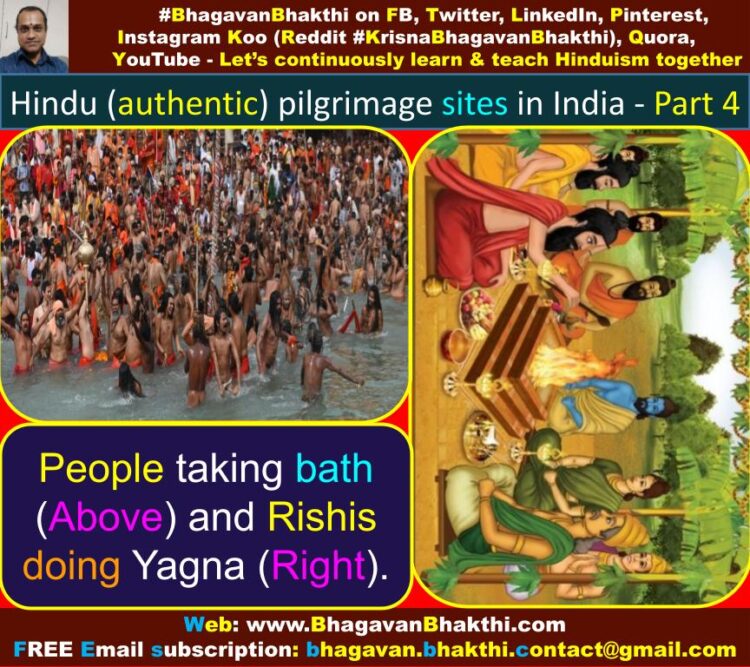
Ahobilam (Ahobila) : In Hindu texts, this place is called as Ahobala (अहोबल / ಅಹೋಬಲ / ahōbala).
Ahobilam (Ahobila) Lord Narasimha Swamy temple is situated on the Upper Ahobilam (Ahobila) at a distance of 8 kms from Lower Ahobilam (Ahobila).
This temple is located around 35 kms from Nandyal.
It is this place where Lord Narasimha Swamy appeared from the pillar to save Prahlada by killing the demon King Hiranyakashipu (Hiranyakashyap).
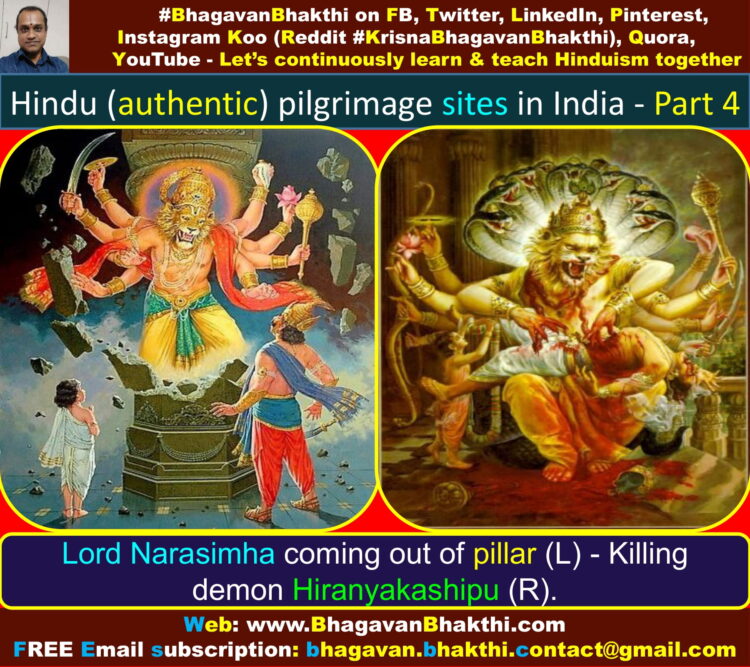
Presiding deity of this temple is believed to be ‘svayambu’ (self manifested) and worshipped as ‘Lord Ahobilam Narasimha Swamy’ and also called as ‘Ugra Narasimha’.
The name ‘Ugra Narasimha‘, because Lord Narasimha Swamy appears here in ‘His fierce form‘.
Nine temples are dedicated to ‘Lord Narasimha’ (An avatar of Lord Vishnu).
These nine temples are called as ‘Nava Narasimha‘ temples.
All these nine temples are situated at Ahobilam (Ahobila) in today’s Kurnool district in today’s Andhra Pradesh.
The ‘Nava Narasimha‘ temple (Ahobilam) names are as given below:
Ahobilam Narasimha Temple
Varaha Narasimha Temple
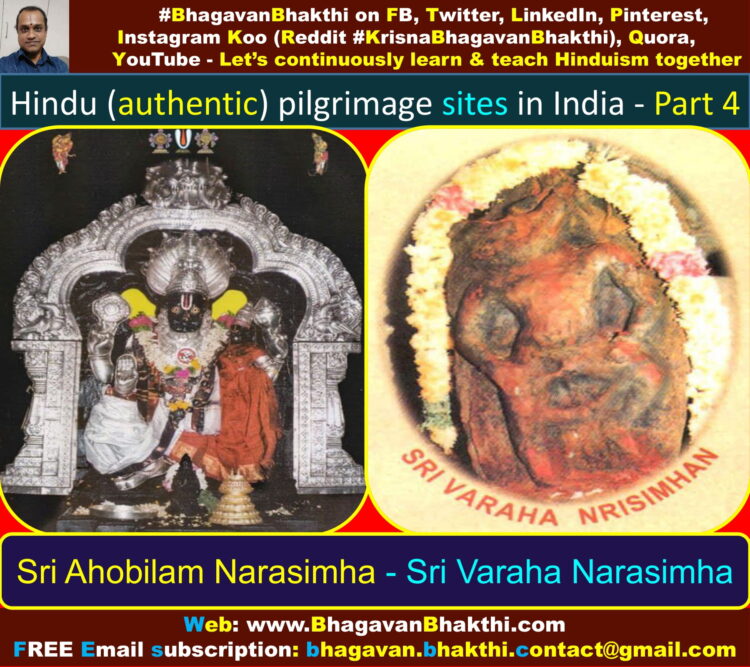
Jwala Narasimha Temple
Malola Narasimha Temple
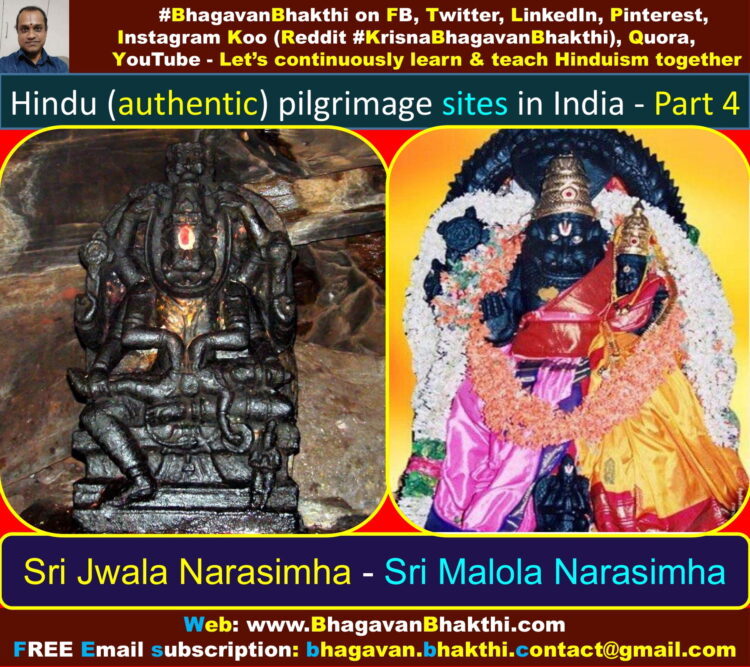
Karanja Narasimha Temple
Yogananda Narasimha Temple
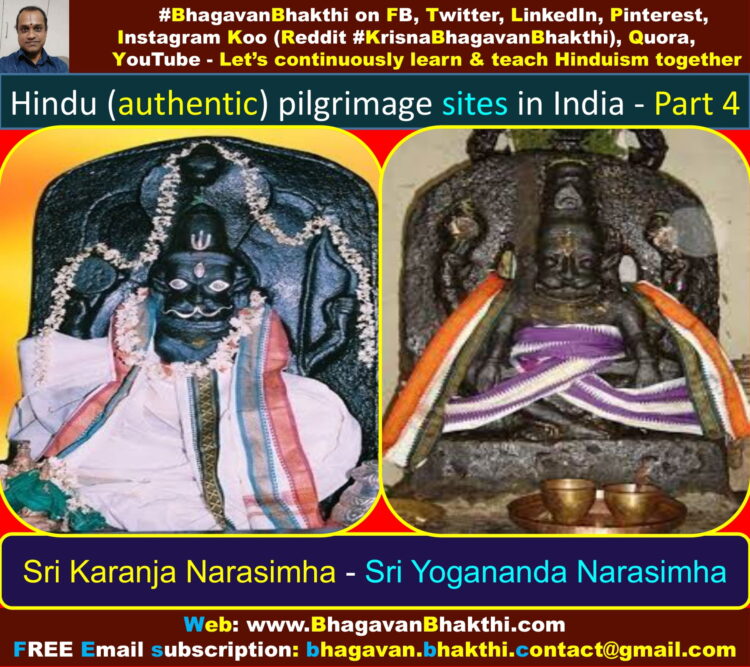
Chatravata Narasimha Temple
Paavana Narasimha Temple
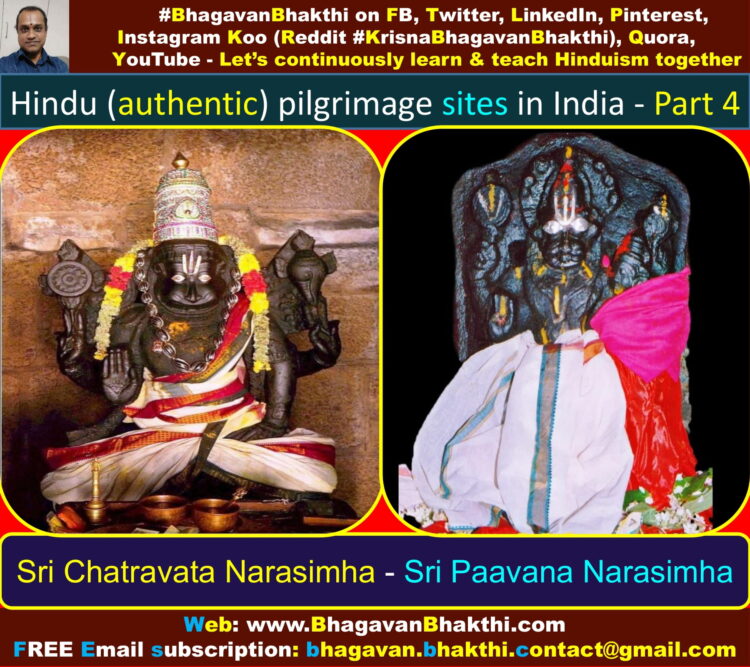
Bhargava Narasimha Temple
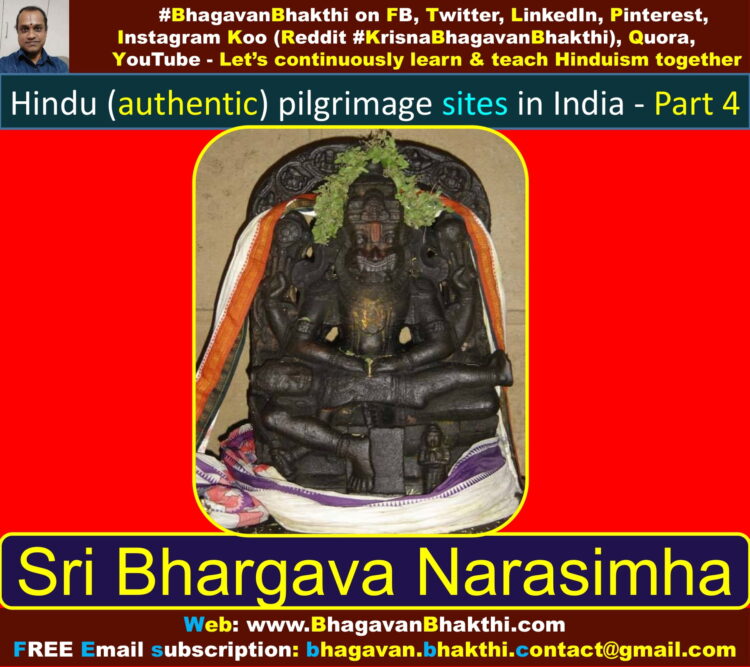
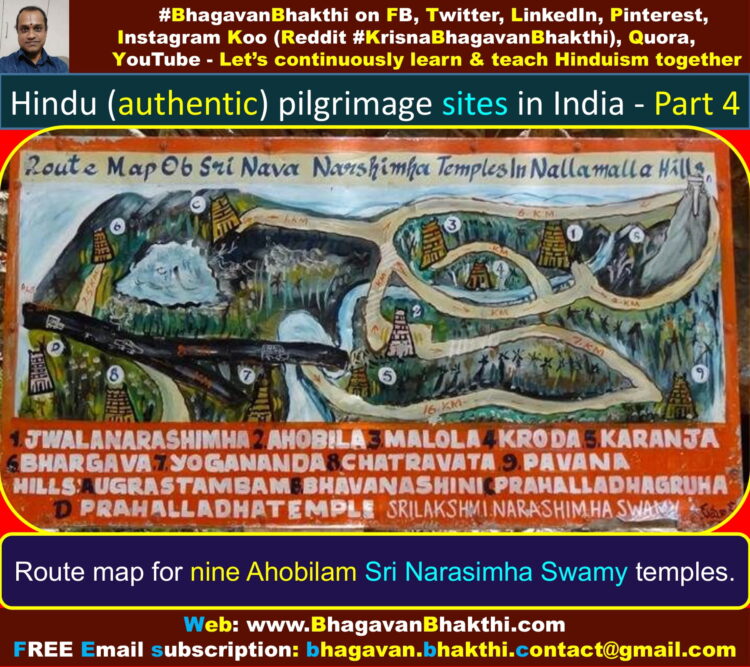
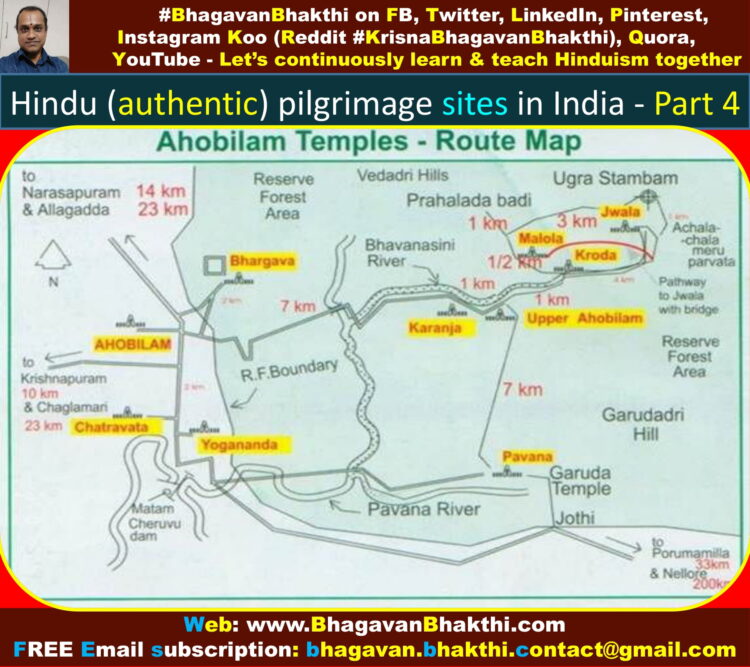
Bhavanashini river : Guru Sri Vadiraja Tirtha explains ‘Bhavanashini‘ river as given below:
This river Bhavanashini flows in Ahobilam (Ahobila) as holy river which provides ‘Abhisheka jala’ (Abhisheka water) and ‘Kamala Pushpa’ (Lotus flowers) for the Lord Narasimha Swamy.
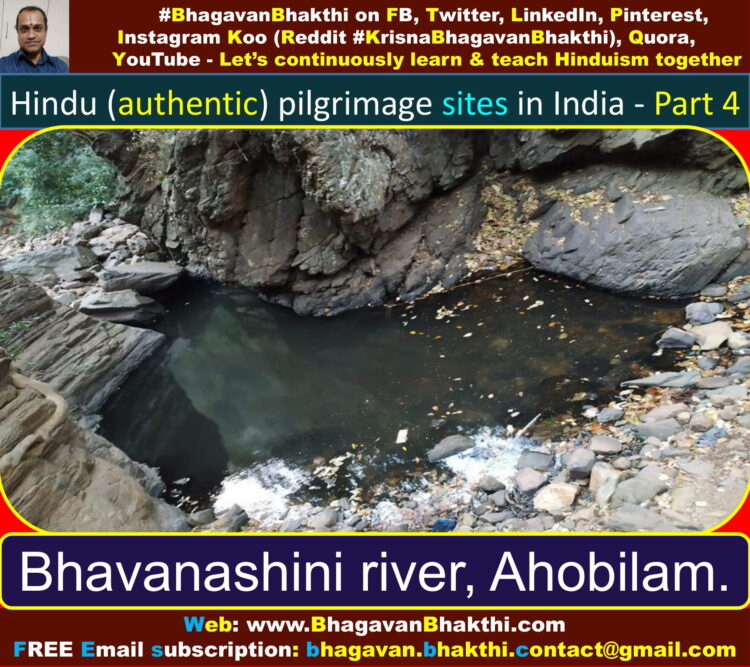
Nivrutti Sangam (Sangamam) (Sangama) : It is Sangamam (confluence) of the river Krishna and river Tungabhadra.
(That is, confluence of these rivers : Krishnaveni, Malaprabha (Malapahari), Bhimarathi (Bhima river), Tungabhadra and Bhavanashini).
This place ‘Nivrutti Sangam‘ is about 30 kms from today’s Kurnool.
Due to the construction of the Srisailam dam, this place is now submerged under water and very rarely visible (during summer days).
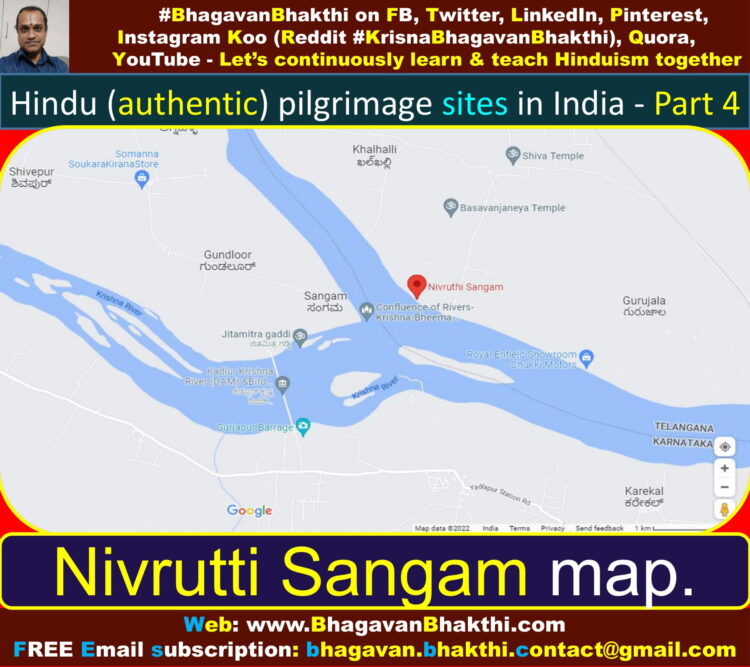
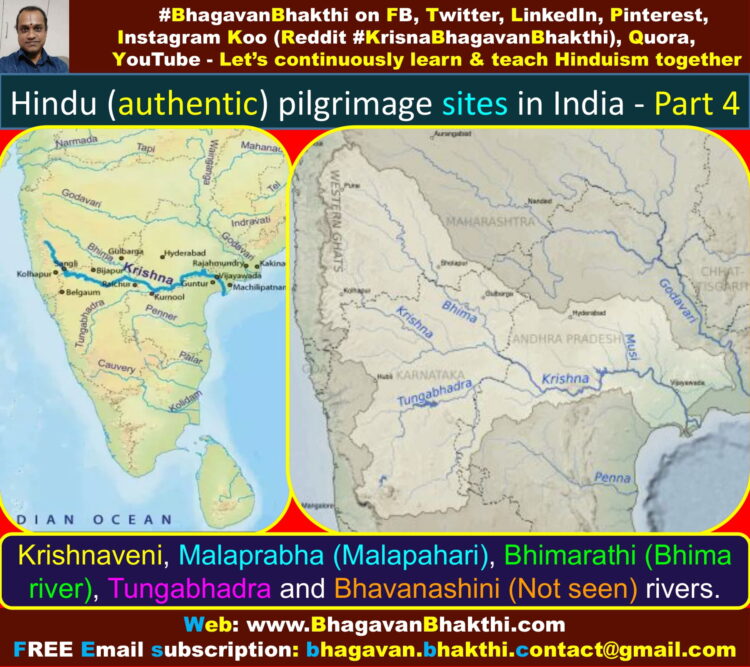
Tungabhadra river : It is the sweetest water on earth to drink. It originates from Varaha Parvata (hills) (Gangamoola).

Tunga river and Bhadra river merges at Kudli, after flowing separately from their origin place.
These two divine rivers, that is, Tunga river and Bhadra river have originated from the tusks of Lord Varaha (Lord Vishnu avatar).
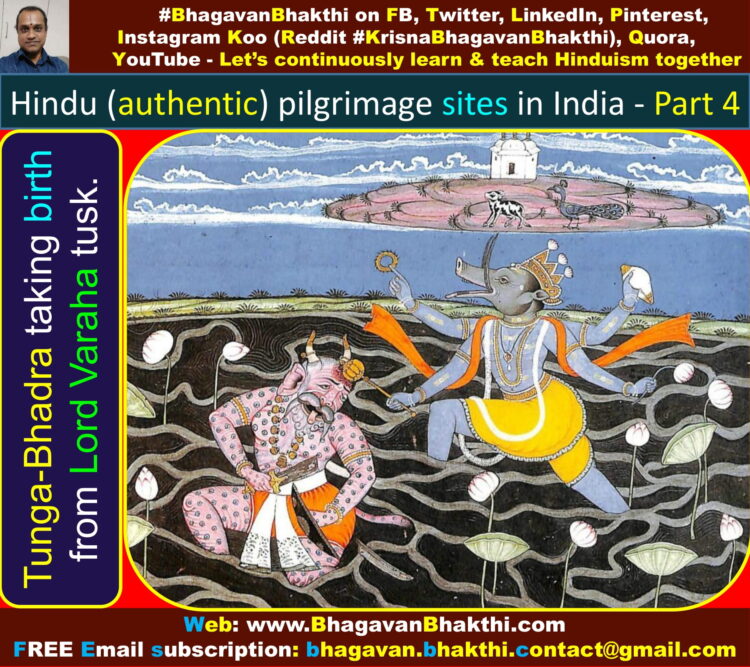
Hampi Vittala temple : The divine place ‘Hampi‘ is located at a distance of 15 kms from today’s Hospete (Hospet).
Hampi used to be the capital of ‘Vijayanagara empire‘.
This temple was one of the most beautiful temples of the Vijayanagara Kingdom in the 16th century.
After the fall of Vijayanagara empire in the battle of Talikota, this temple was destroyed by Islamic invasions.
The highlight of Lord Vittala temple is its impressive pillared halls and the stone chariot.
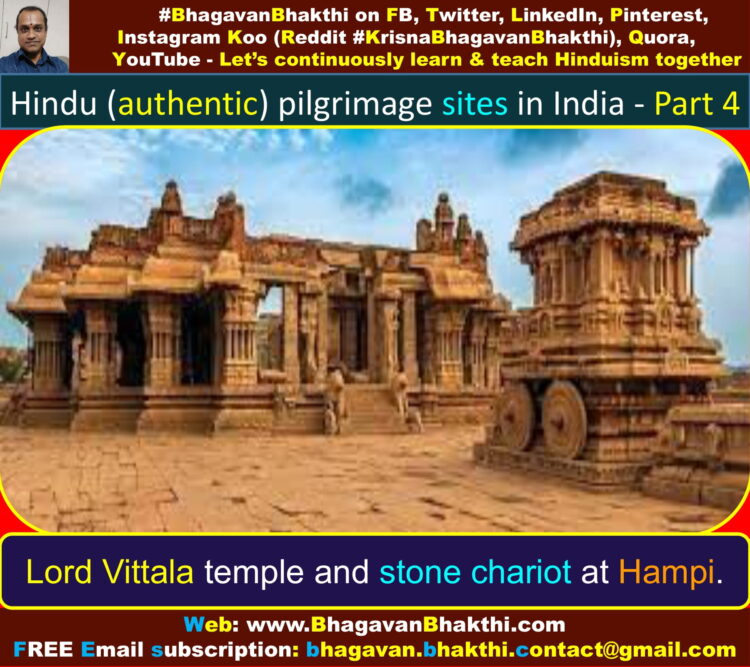
The halls are carved with an overwhelming array of sculptures on the giant granite pillars.
The stone chariot located inside the campus is almost an iconic structure at Hampi.
Note : The attributes like stealing and courting are actually the holy pastimes of Lord Krishna.
Lord Krishna steals sins from all devotees and grants all of them their desires.
Since Lord Krishna’s body is not made from the nature like us, his association with divine women doesn’t violate shastra.

In older days, the name Hampi was known as Pampa. The word or name Hampi is mispronounced name from Pampa.
Virupaksha temple : Hampi (Pampa) used to be the main attraction of the Vijayanagara Empire.
And the Virupaksha Temple is among the group of monuments built during 1336 – 1570 A.D.
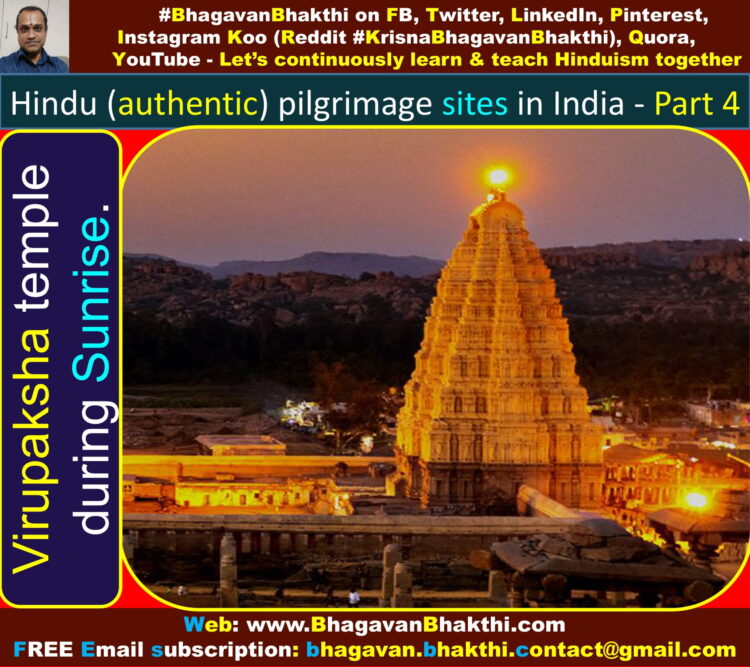
Virupaksha temple is situated on the banks of river Tungabhadra near Hemakuta hills.
The main temple is east facing and has two large courtyards, one leading to the other.
Guru Sri Vadiraja Tirtha says, may Lord Virupaksha, the lord of ‘Pampa Kshetra’ (Now it is called as Hampi), always grant the opulence to the noble.
This temple is like the crown jewel among Kings and is resplendent around the Hemakuta hills.
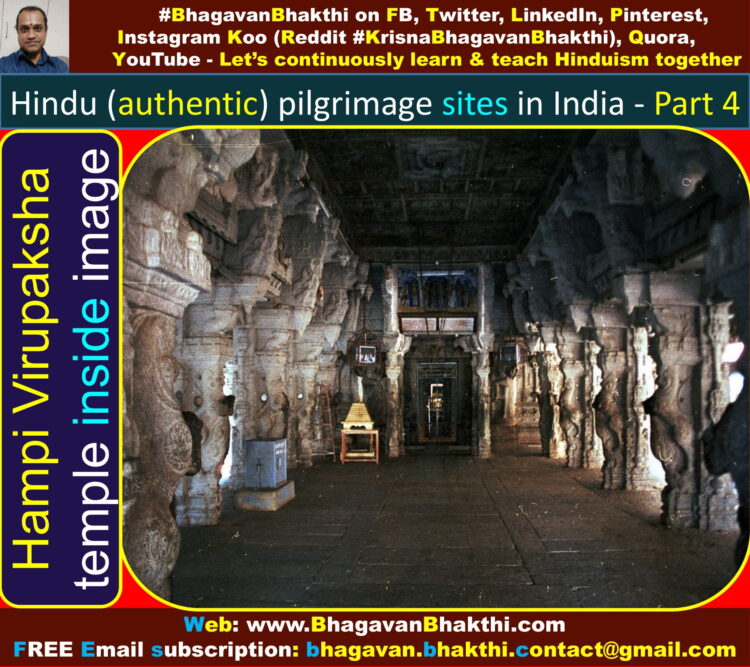
Pampa Kshetra : This holy place is also called as ‘Dakshina Kashi’ (Southern Kashi).
Guru Sri Vadiraja Tirtha describes Pampa as a divine place (Kshetra) that destroys all the sins.
Guru Sri Vadiraja Tirtha questions that, “is there any sin(s) that this place Pampa (Hampi), which grants wealth to men, can’t remove those sins(s)?”
“Merely by chanting the name of Pampa it turns sins upside down“
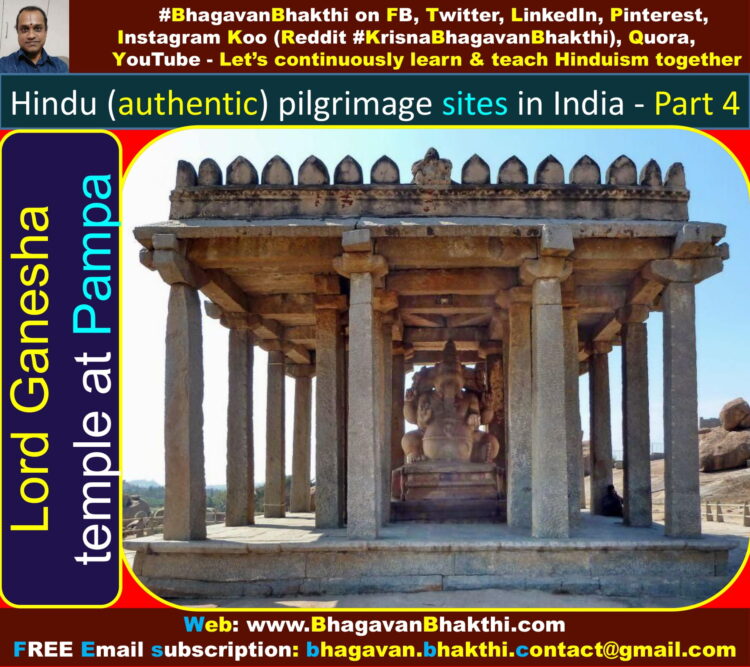
There is an amazing fact about the name / word Pampa as given below:
When the name Pampa is spelt in opposite way, it becomes paapam (sin).
Hence the use of this clever method to praise the sin-relieving ability of this Kshetra (pilgrimage site).
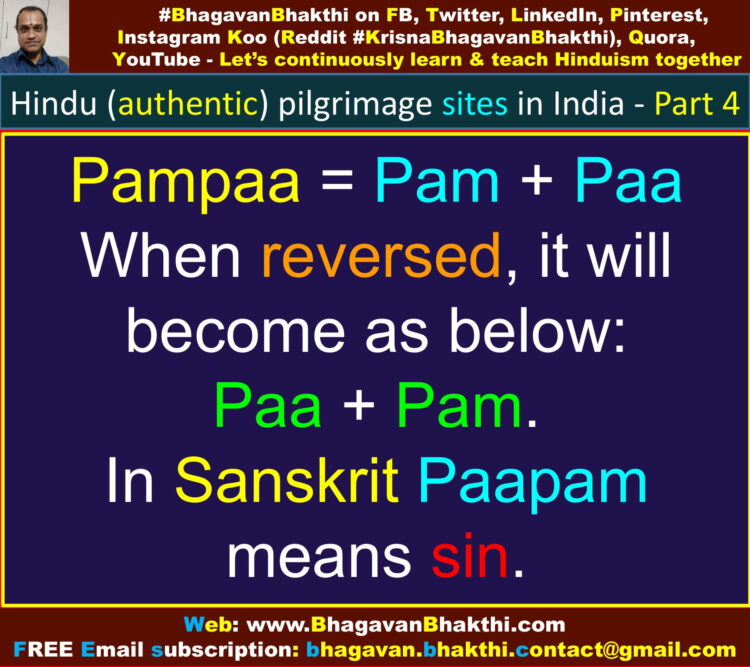
Hampa Devi (Bala Hampa Devi) : Goddess Sri Durga Devi temple is situated on Pampa saravora on the banks of the river Tungabhadra.
Guru Sri Vadiraja Tirtha in his grantha (text) ‘Tirtha Prabandha‘ says that:
मालाभिः समलङ्कृताsतिविमला लोलोल्लसल्लोचना | शूलेन त्रिदलेन दैत्यकलने कालायितेन द्विषः |
फाले पादतलं निधाय बलिनं योन्मूलयन्ती खलं | बाला मे बलदाsस्तु लोलवलया श्रीबालहम्पालया ||
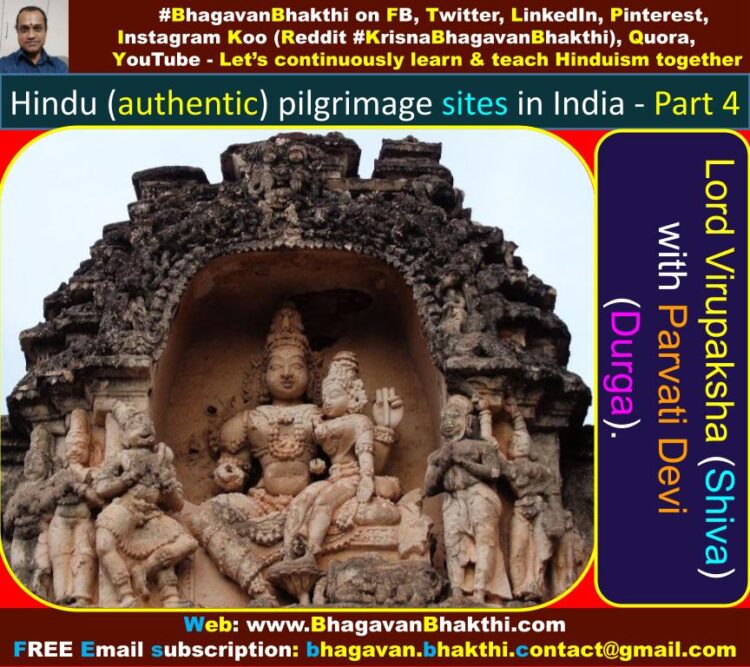
Meaning of this shloka : May Bala Hampa Devi, someone is wearing numerous garlands, someone who is very well decorated,
someone who is highly pristine, someone who has shining and flickering eyes,
someone who is like ‘kalamrityu‘ in destroying demons, someone who is uprooting the powerful enemy Mahishasura with her trident after placing her foot on his forehead,
someone who is wearing most beautiful bangles, someone who is a ‘kumari’ since eternity, always grant me strength!
We should note that, near the Pampa Sarovara at Hampi, there is Goddess Sri Durga Devi temple, known as Hampalaya.
This above shloka is in praise of the deity of that temple (Sri Hampa Devi / Sri Bala Hampa Devi).
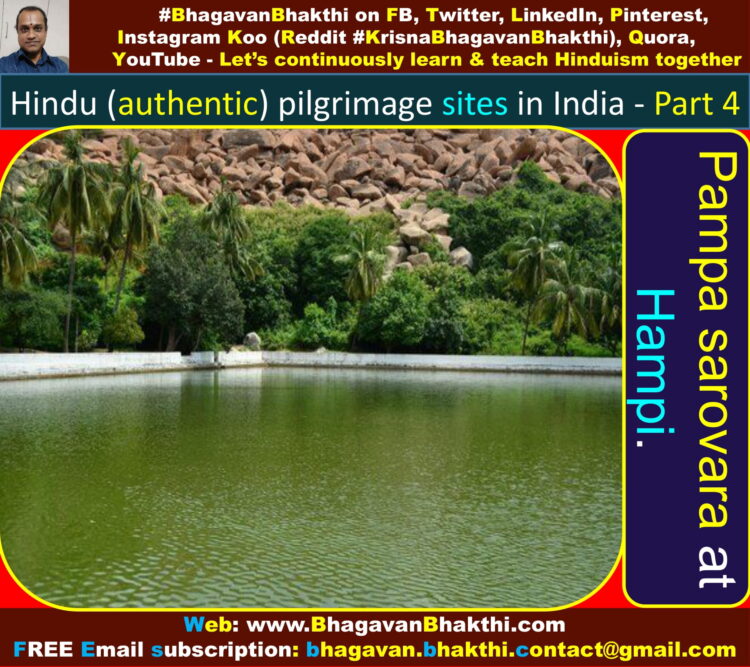
Anegundi (Anegondi) : Guru Sri Vadiraja Tirtha praises ‘Nava Brindavana‘.
This place is surrounded by different hills on three sides and Tungabhadra river on the other side.
According to Indian legends, Anegundi (Anegondi) was called as ‘Kishkinda‘ in the earlier time, that is, the kingdom of monkeys.
The monkey King Sugriva after defeating his brother Vali with the help of Lord Rama, re-established ‘law and justice‘ in the city and ruled there.
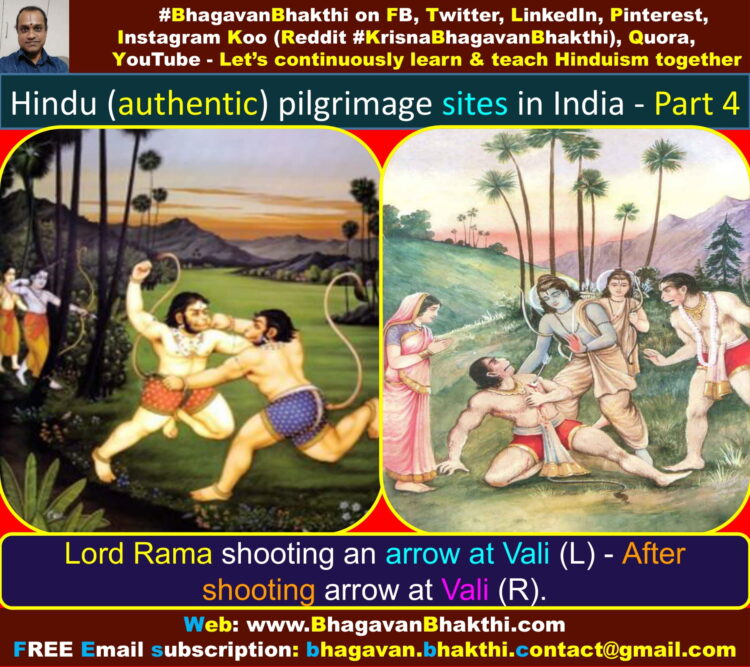
In earlier this place Anegundi (Anegond) was also called as ‘Gaja-gahvara‘ (A Sanskrit name).
In Kannada , Anegundi (Anegondi) means the elephant pit.
This place was used for bathing the elephants of ‘Vijayanagara Empire’ and also became the first capital of that empire.
It is at Anegundi (Anegondi) that Lord Hanuman was born as the son of Anjana Devi (Mother) and Kesari (Father).
This is an extremely sacred place, as it is the birth place of Lord Hanuman and also for the below reason.
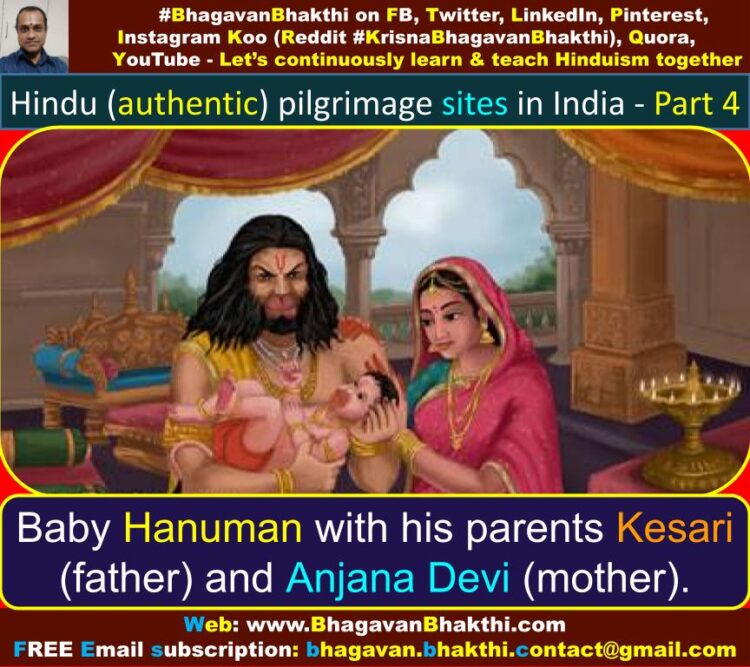
This place is especially highly pious place for the followers of Sri Madhwacharya’s siddhanta (theory).
Here there were eight Brindavanas during Guru Sri Vadiraja Tirtha visit (Now, 9 Brindavanas are present).
Guru Sri Vadiraja Tirtha described those 8 Yatis (Saints) as ‘Ashta Diggajas’ (8 great and divine people) who are bearing the burden of this universe.
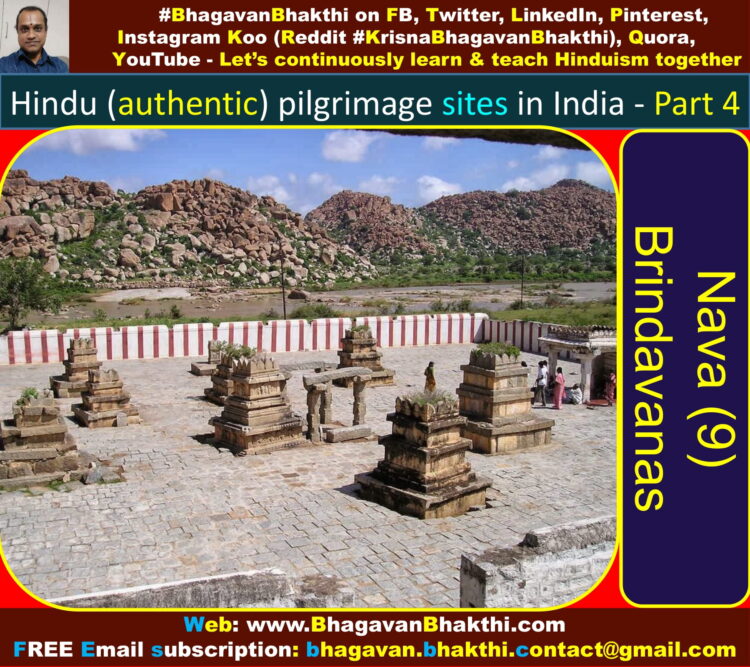
Malkhed Sri Jaya Tirtha : He was a great Sanyasi in the Dvaita Guru Parampara.
Sri Jaya Tirtha was present on this earth for just around 43 years from A.D.1345 – A.D. 1388.
But he has done highly commendable works on the Sanatana Dharma in that short period.
He is considered as an avatar of Lord Indra Deva.
Sri Jaya Tirtha of Dvaita Siddhanta is also known as ‘Teekacharya’.
Guru Sri Vadiraja eulogizes the work of Sri Jaya Tirtha in a text called ‘Nyaya Sudha and Teekas‘.
Malkhed (place) is in Gulbarga District in Karnataka state. It is 40 kms away from Gulbarga.
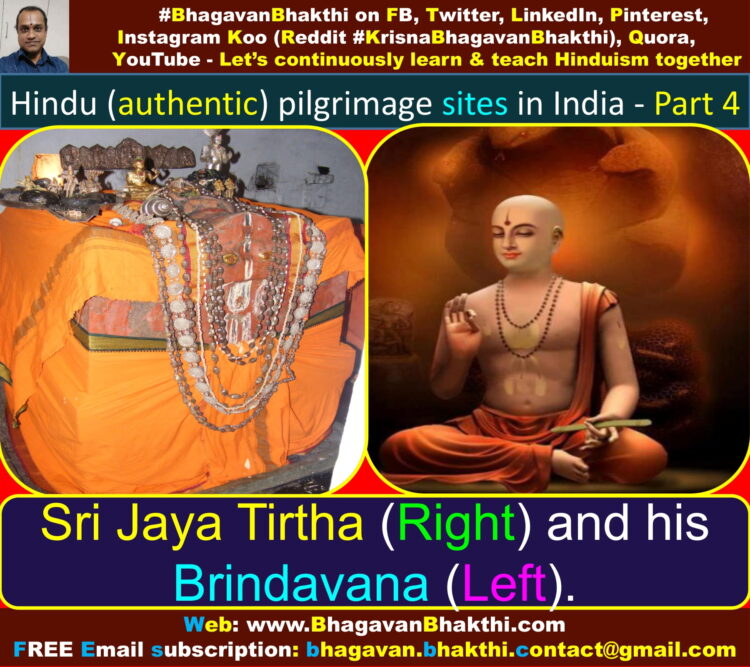
Tirumala (Tirupati) Lord Srinivasa : Tirumala (Tirupati) was known as Sheshadri (Sheshachalam) during Dvapara Yuga, Anjanadri (Anjanachalam) in Treta Yuga and
Vrishabhadri (Vrishabhachalam) in Krita Yuga (Satya Yuga) and in Kali Yuga it was called as Venkatadri (Venkatachalam).
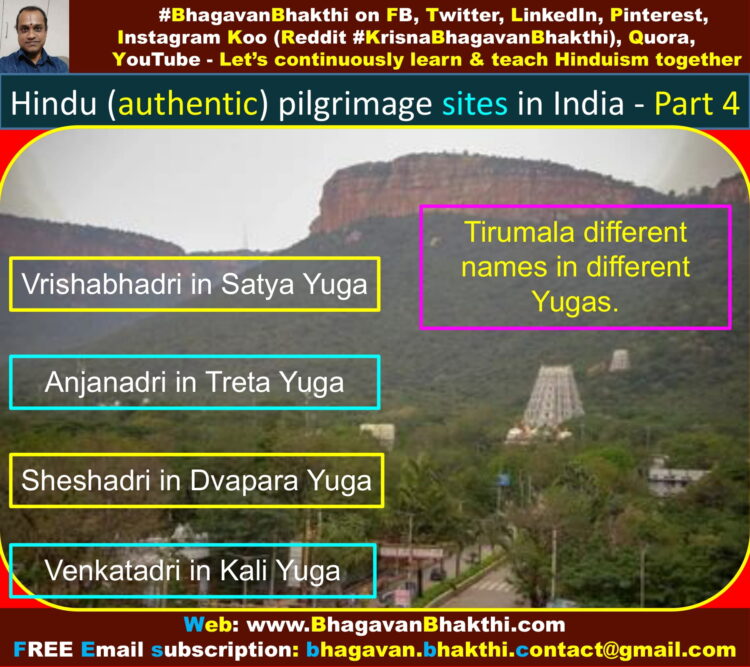
The glory of Tirumala (Tirupati) is described in Varaha Purana.
Tirumala (Tirupati) is the abode of Lord Venkateshwara (Lord Srinivasa) (Lord Balaji).
‘Sri Venkatachala Mahatyam’ contains Puranic details from the twelve ‘Maha Puranas‘.
The Puranic legends say that, after the Pralaya Kalpa preceding the great tribulation,
the Supreme Lord Vishnu, revealed Himself in the form of a Shweta Varaha (White Boar) and rescued the Bhudevi (Mother Earth).
And also recreated earth and having re-established the whole universe, He decided to stay on the earth for some time to protect the good and destroy the evil completely.
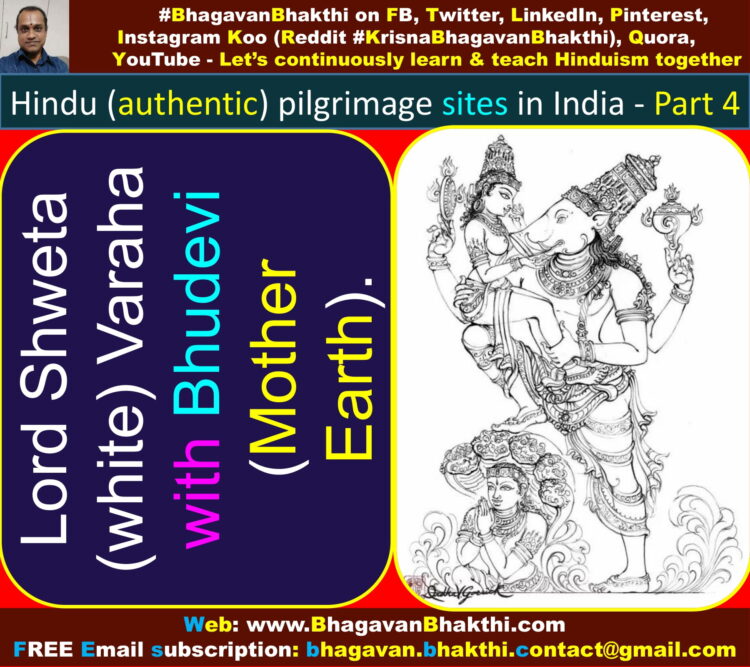
Thus Lord Vishnu revealed Himself earlier in the previous avatar of Lord Varaha on the bank of the Varaha Tirumala.
That is, at the northern portion of Pushkarini at today’s Tirumala (Tirupati).
This avatar (incarnation) as the Shweta Varaha (White Boar) is enshrined in the ‘Adi Varaha Swamy‘ temple on the north western bank of the Pushkarini at Tirumala.
This temple of ‘Adi Varaha Swamy‘ is older than the temple of Lord Venkateshwara (Lord Srinivasa) (Lord Balaji) and claims precedence in the worship and Nivedana.
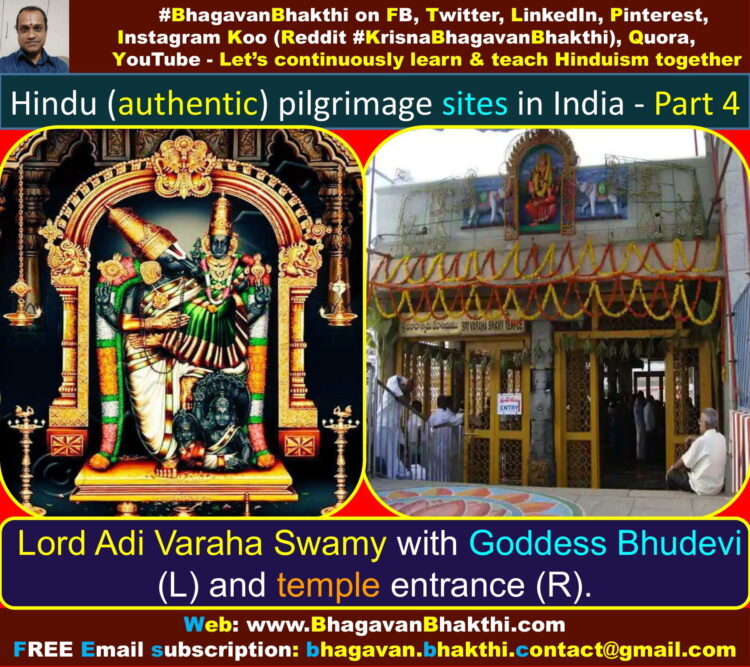
Lord Vishnu Came to earth searching Goddess Sri Maha Lakshmi Devi who left Vaikuntha.
Goddess Sri Maha Lakshmi Devi left Vaikuntha, because of the anger caused by Maharishi Bhrigu hitting Lord Vishnu’s ‘Vaksha Sthala’ (Chest part).
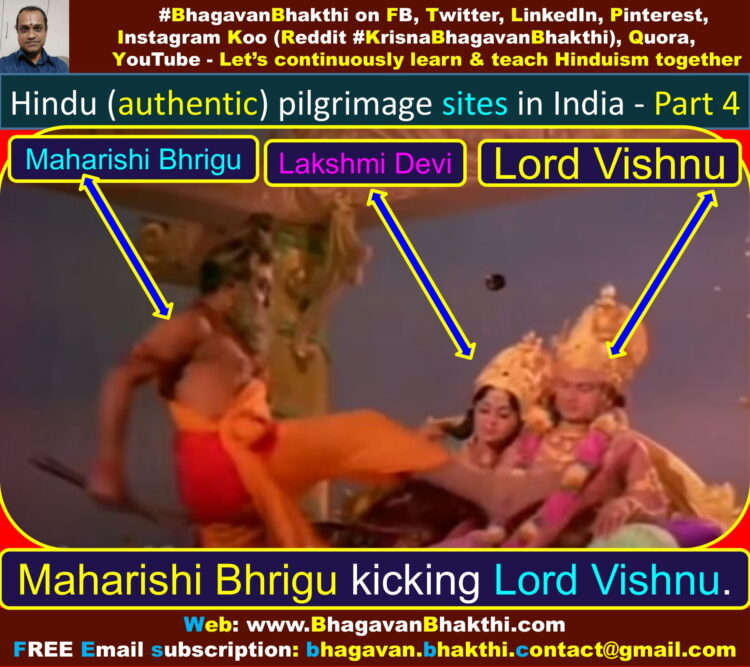
Lord Vishnu lived as Lord Srinivasa and married Goddess Sri Padmavati Devi and stayed in Tirumala.
Even today Lord Srinivasa (Lord Vishnu) is staying in Tirumala (Tirupati) to bless the people of Kali Yuga.
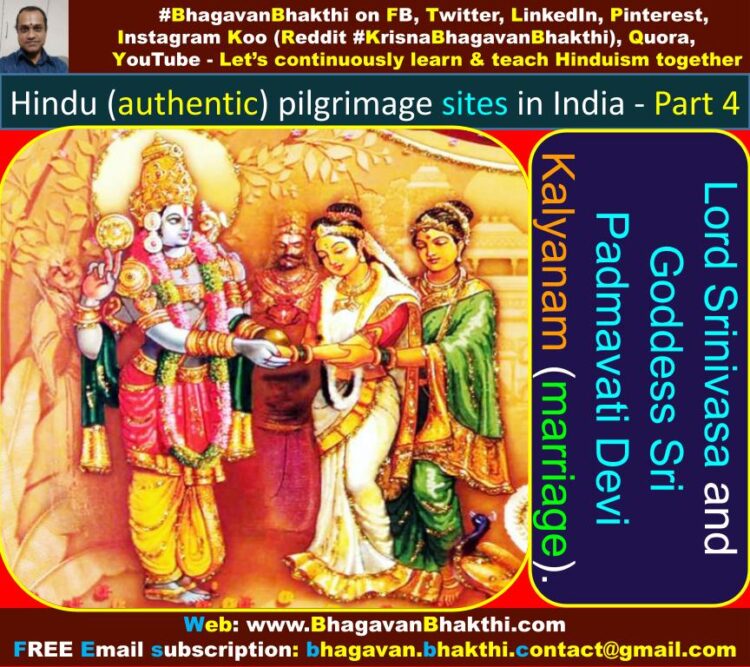
Why Lord Srinivasa is staying on Tirumala hills?
Guru Sri Vadiraja Tirtha gives a very creative logic for why Lord Srinivasa resides on top of the hill.
Guru Sri Vadiraja Tirtha says that, Lord Srinivasa by virtue of being on top of the hill, is able to see his devotees all over the world in every direction.
And therefore develops compassion on his devotees and blesses them all.
Just not to misread the great ability of Lord Vishnu (Lord Srinivasa), Guru Sri Vadiraja Tirtha says that –
The name of Lord Srinivasa by saying him as ‘Vishwathaschakshu’ (विश्वथ चक्षु / ವಿಷ್ವಥ ಚಕ್ಷು / viṣvatha cakṣu).
That is, Lord Srinivasa (Lord Vishnu) is someone who has eyes everywhere, i.e., he is someone who is omnipresent.
Hence he truly does not need the aid of any mountain or other things.
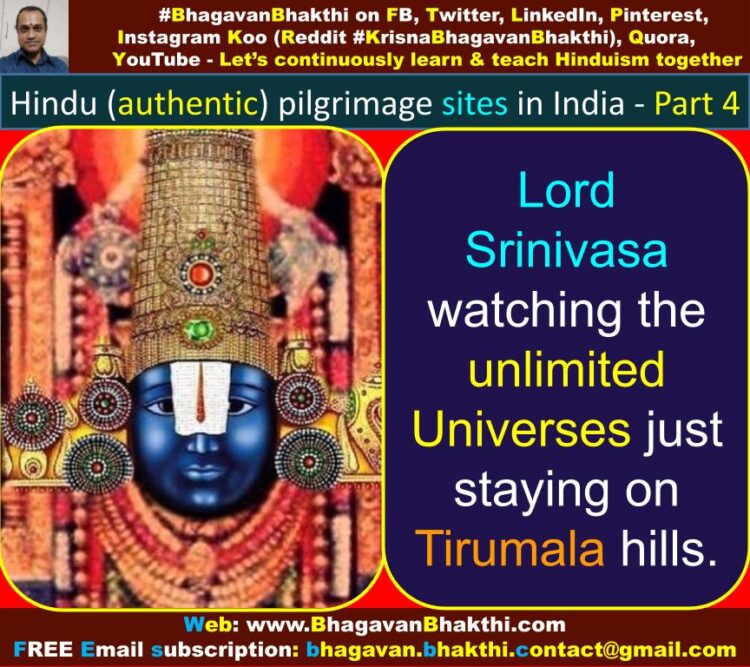
Tirumala (Tirupati) is one of the ‘Swayam Vyakta Maha Kshetras‘ (Self manifested great pilgrimage place).
Tirumala (Tirupati) is also known as ‘Bhu Vaikuntha‘ on earth.
Tirumala (Tirupati) is located on the Venkatadri (Venkatachalam) mountain range.
Tirumala (Tirupati) has numerous Tirthas (pilgrimage sites) over the entire mountain range.
The most important one amongst them is the ‘Swami Pushkarini Tirtha‘ right next to the main temple of Lord Srinivasa.
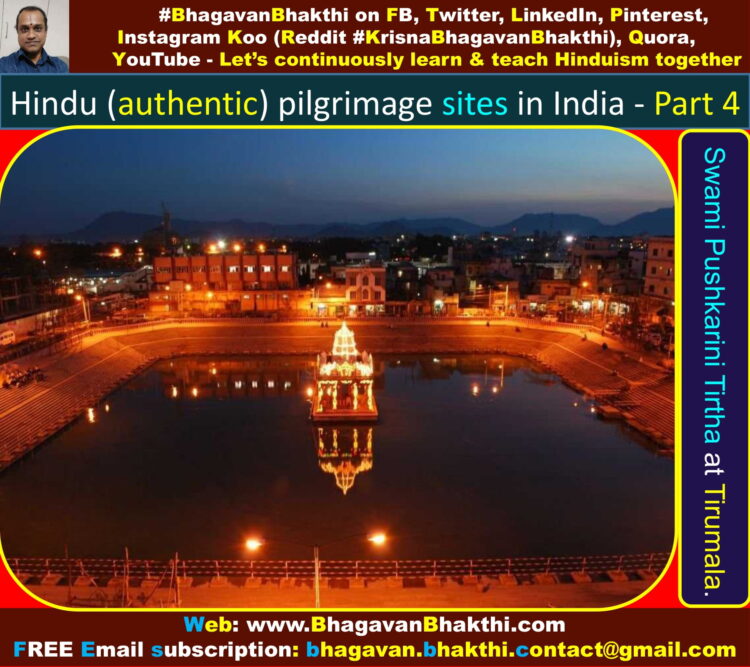
Lord Srinivasa is making it 100% sure through his lotus like hands that –
The effects of this ‘ocean like Sansar’ (From birth until death) will only reach till the waist of those people whose shoulders are decorated with the signs of Shankha and Chakra and who worship His (Lord Srinivasa) feet.
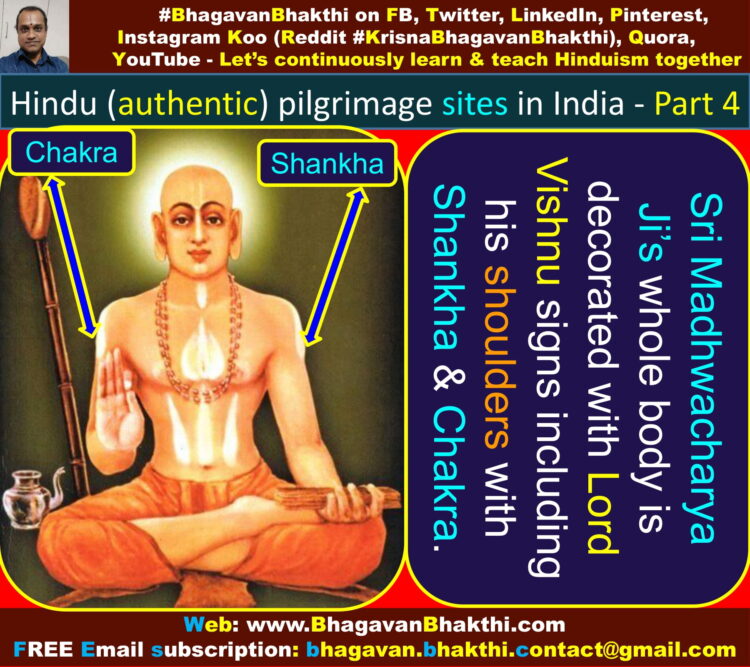
Guru Sri Vadiraja Tirtha very beautifully narrates the method of meditating over the deity of Lord Srinivasa at Tirupati (Tirumala) as given below:
Lord Srinivasa (Lord Venkatesha) has four hands.
Lord Srinivasa’s (Lord Venkatesha) upper two hands hold the Shankha (Panchajanya) and Chakra (Sudarshana).
Hence it is an indication that, being a ‘Vaishnava (Vaishnav)‘ and displaying the signs of Shankha (Panchajanya) and Chakra (Sudarshana) is highly important for his devotees.
Lord Srinivasa’s (Lord Venkatesha) lower right hand is pointing towards his feet. This means, his devotees must always worship his feet eternally.
Lord Srinivasa’s (Lord Venkatesha) lower left hand is holding his waist. This shows that, his true devotees will never experience the bad effects of life.
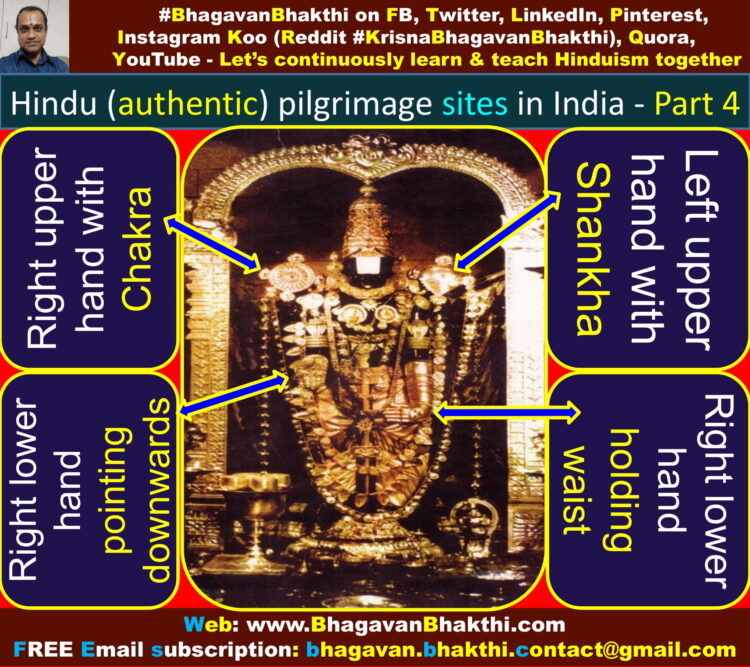
In other words if we need to understand, the ocean of Sansar (From birth until death) will never rise above one’s waist, that is, bad effects of life will always be contained.
Lord Srinivasa (Lord Venkatesha), whose body color is like the bluish clouds, who is dear to all his devotees,
after seeing the wealth residing in his devotees’ houses grants their desires again and again, hoping to take it (the wealth) to his possession.
After this, Lord Srinivasa notices that wealth growing a thousand times in the devotees’ houses and thus, out of surprise, stays back in their house permanently.
Guru Sri Vadiraja Tirtha at the outset, it appears he is describing, in a lighter vein, how Lord Srinivasa takes money from devotees.
However, Guru Sri Vadiraja Tirtha reveals few important points here.
Goddess Sri Maha Lakshmi Devi always resides along with Lord Srinivasa.
Whenever a devotee offers his wealth to the Lord Srinivasa, Goddess Sri Maha Lakshmi becomes pleased with him and grants him much more wealth and opulence and also associated happiness to the devotees.
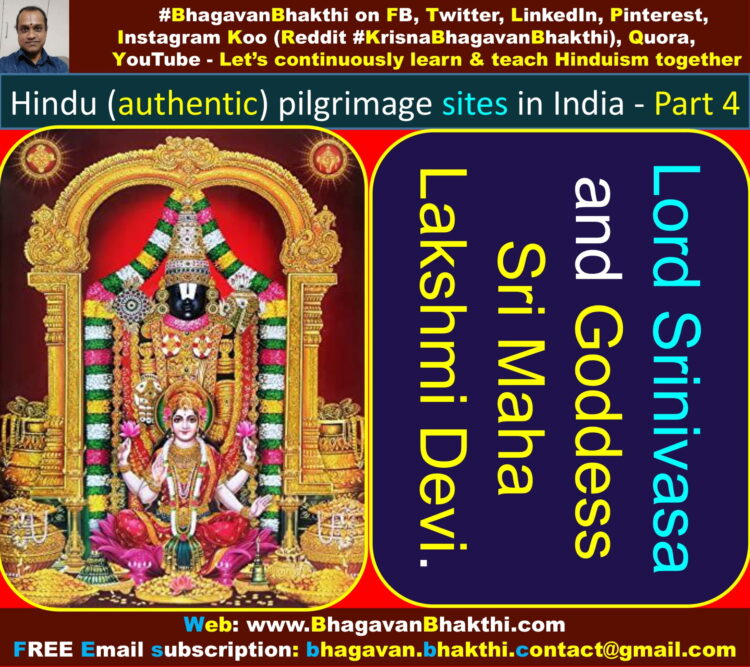
In turn, Lord Srinivas again decides to bless his devotees seeing the blessings of Goddess Sri Maha Lakshmi Devi
If one desires the blessings of other Devatas (Demigods), one must possess the highest devotion towards Lord Vishnu. That is the subtle message in this hidden message.
Note : Guru Sri Vadiraja Tirtha wants to highlight the fact that, there is no one who is even equal to Lord Vishnu (Srinivasa).
And thus, the question of someone being greater than Lord Vishnu doesn’t even arise at all.
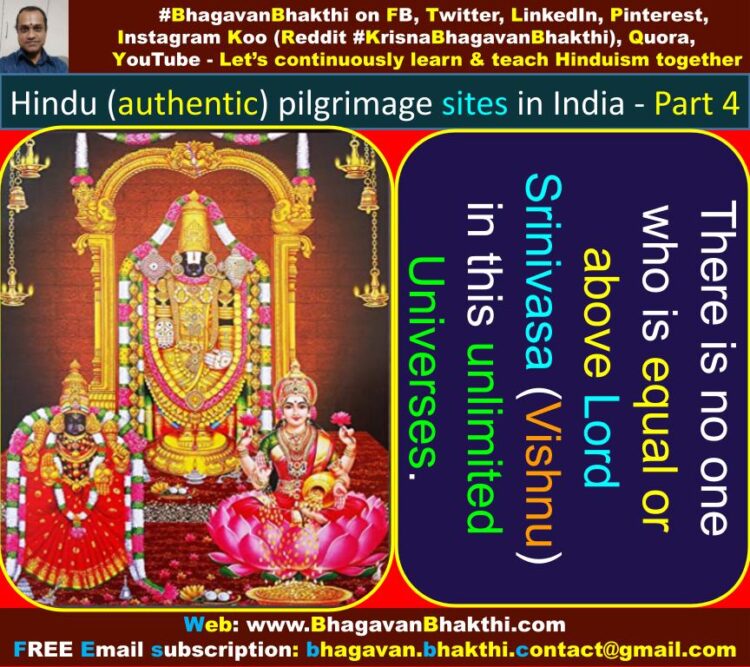
Swarnamukhi (Suvarna Mukhari) river, Tirupati : This river flows near Thiruchanur (Also known as ‘Alumelu Mangapuram‘).
Guru Sri Vadiraja Tirtha eulogizes the glory of Swarnamukhi (Suvarna Mukhari) river of Tirupati as given below in this shloka:
सुवर्णमुखी संसेवे सुवर्णाभं पयस्तव | सुवर्णशोभिवदनं कुरु मामम्ब निर्मलम् ||
Meaning of the above shloka : O Swarnamukhi (Suvarna Mukhari) river!
The one whose face has a golden radiance, I shall drink your golden hued water a lot. Please make me pure!
Swarnamukhi (Suvarnamukhi) river is near Tirupati. On this same river bank the famous ‘Kalahasti Kshetra‘ is located.
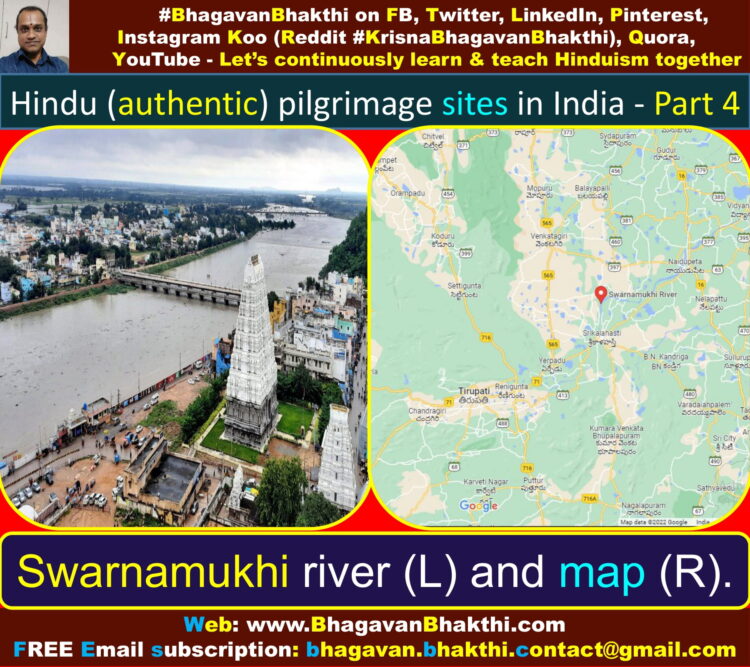
Kanchi Varadaraja Swamy : The divine 40 ft long deity of ‘Lord Athi Varadaraja Perumal‘ (Athi Varadar in Tamil) (Lord Vishnu) in reclining posture is made of ‘Athi wood‘.
This huge deity is brought out once in every 40 years for the darshan of the devotees.
Chakkarathazhvar Deity – The shrine of the discus of Lord Perumal (Lord Vishnu) is with 16 hands holding conch and discus is on the eastern side of the temple tank.
Lord Varadaraja Perumal (Lord Varadar) in His standing posture facing west blesses the devotees with all mercy.
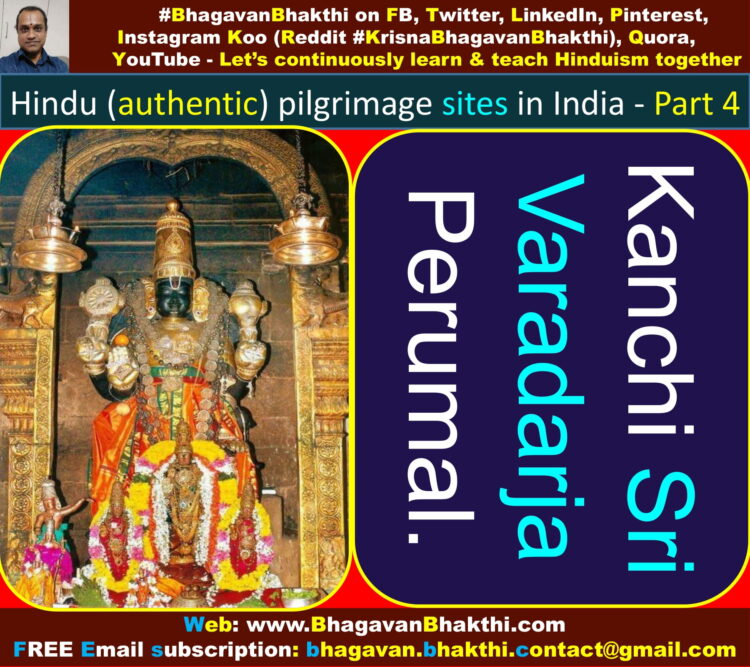
As Lord Varadaraja Perumal granted a boon, Varam in Sanskrit means boon, that was give to Lord Brahma after a Yajna done by him (Lord Brahma).
Here Lord Vishnu is praised as Lord Varadaraja Perumal.
The place derived the name Athigiri as ‘Iravadam’ elephant lifted Perumal as a Mount, that is, the ‘Athi-Mount‘.
The 24 steps in the temple represent the number of letters in the divine ‘Gayatri Mantra‘.
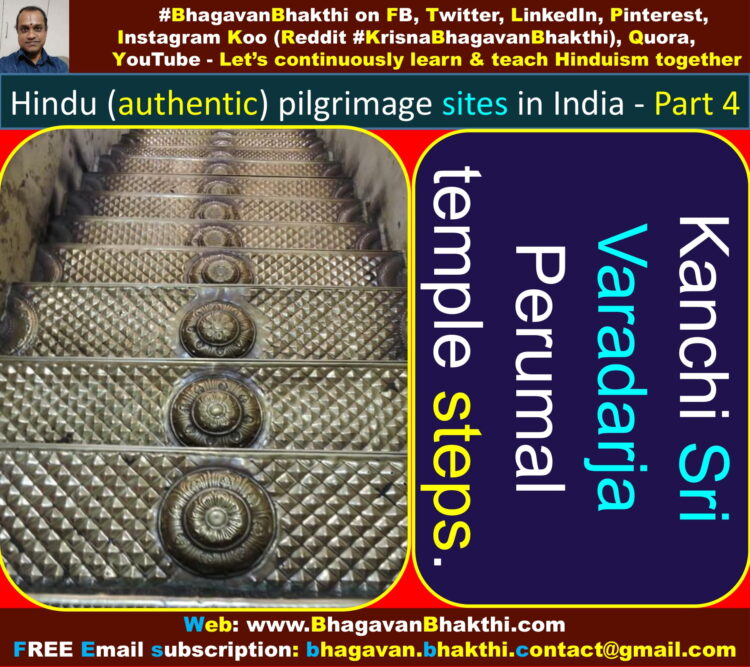
When Lord Brahma performed ‘Satra Yagna‘, Lord Vishnu emerged as ‘Lord Varadaraja‘.
The word Kanchi (Kaanchee) means girdle. Kanchi is considered as the girdle region of Bhudevi (Mother Earth).
Hence Guru Sri Vadiraja Tirtha narrates Lord Varadaraja (Lord Vishnu) as a very romantic and sensual Supreme Personality for having chosen this particular place to stay.
Kanchi Ekambareswarar (Lord Shiva) : Goddess Sri Parvati worshipped Lord Shiva by creating a Linga out of sand under the mango tree.
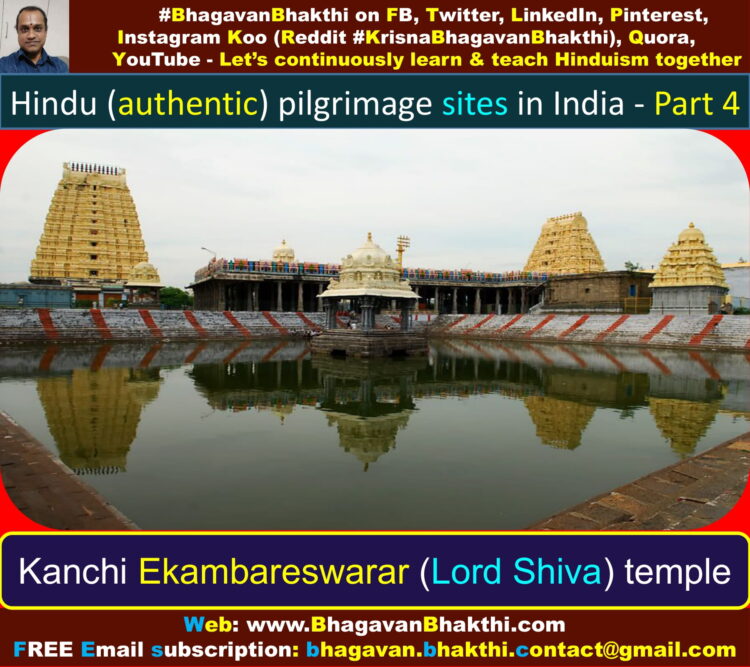
Because of this, Lord Shiva was pleased and came to this divine place of Kanchi.
One of the main temples at Kanchi (Kanchipuram) is that of Lord Sri Ekambareshwara (Ekambareswarar).
There is a mango tree here, at the base of which is an ancient Lord Shiva Linga which is hugged by Goddess Sri Parvati Devi.
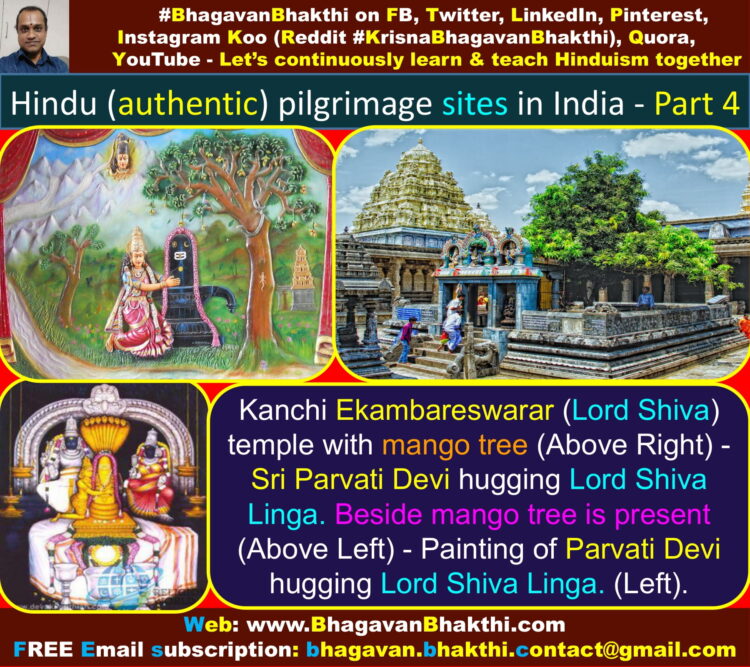
Kanchi Kamakshi : The Goddess Sri Parvati Devi is the form of Goddess Sri Kamakshi Devi in the form of Shakti.
The place where Goddess Sri Kamakshi Devi resides is ‘Gayatri Mandapam‘.
The Goddess Sri Kamakshi Devi lives in temple in 3 forms as given below:
Sri Kamakshi Devi,
Sri Bilahasam and
Sri Chakram.
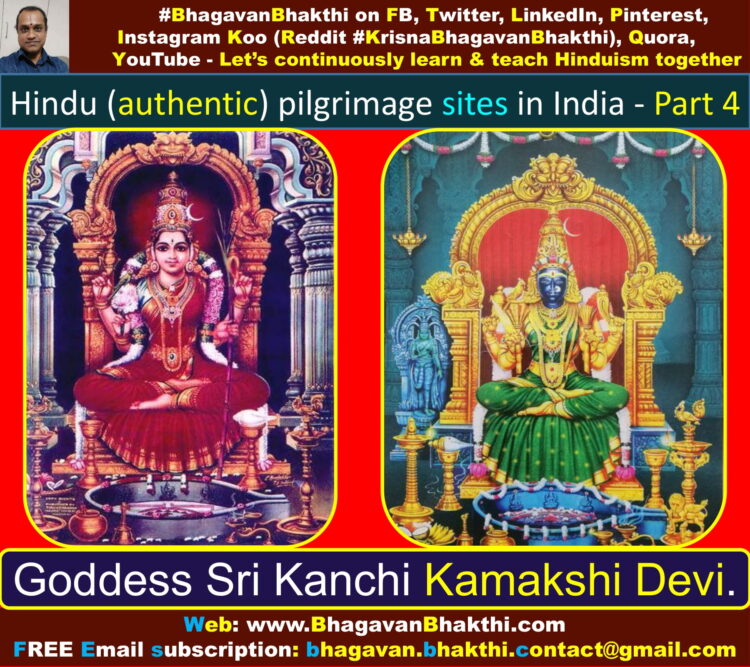
The Goddess Sri Kamakshi Devi is in a sitting posture of ‘Padmasana‘.
The Goddess Sri Kamakshi Devi contains Pasa (Pasha), Angusa (Ankusha), Pushpabana and Sugarcane in her forehands.
Guru Sri Vadiraja Tirtha glorifies the beauty of Goddess Sri Kamakshi Devi in two ways.
Even though her husband Lord Shiva had defeated kama (Lord Kama Deva) himself, Goddess Sri Kamakshi Devi’s beauty was so much that he had immense love towards her.
But being so concerned about her beauty and radiance, Lord Shiva decided to have his first son Lord Ganesha through the dirt (sand like substance) from her skin.

The other son Lord Shanmukha (Lord Kartikeya) had 6 heads.
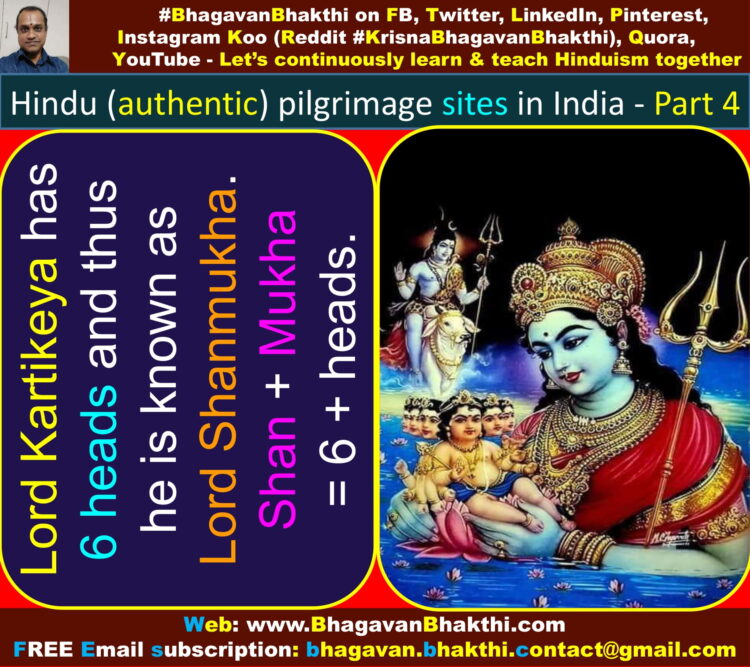
Being worried that Lord Shanmukha will cause problems to his mother if he suckles milk from all his six heads, Lord Shiva made Lord Shanmukha have 6 other mothers.
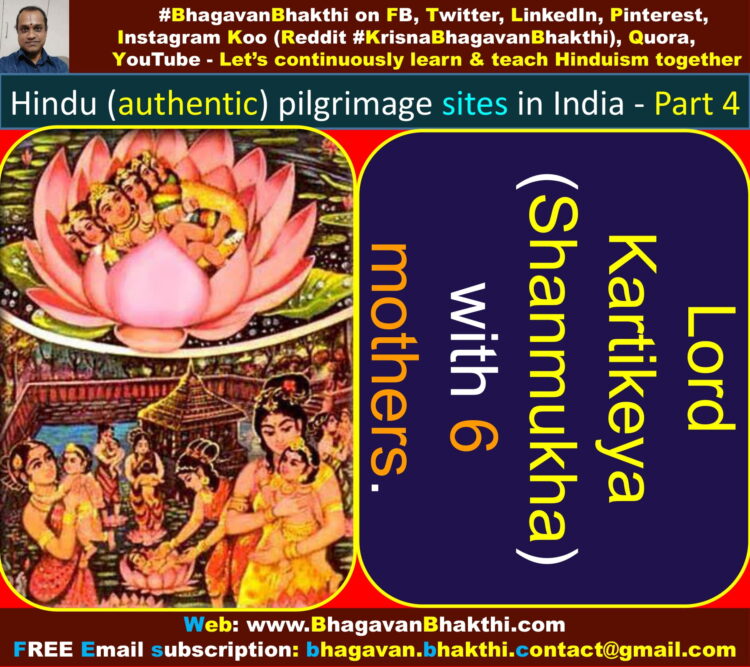
Arunachalam (Arunachalesvara) (Tiruvannamalai) : This place is now called as ‘Tiruvannamalai‘.
Among the five type of Lingas, Agni Linga is present here in Tiruvannamalai.
Here Lord Shiva is called as Sri Arunachalesvara (Arunachalam) and Goddess Sri Parvati Devi is called as Unnamalai Amman.
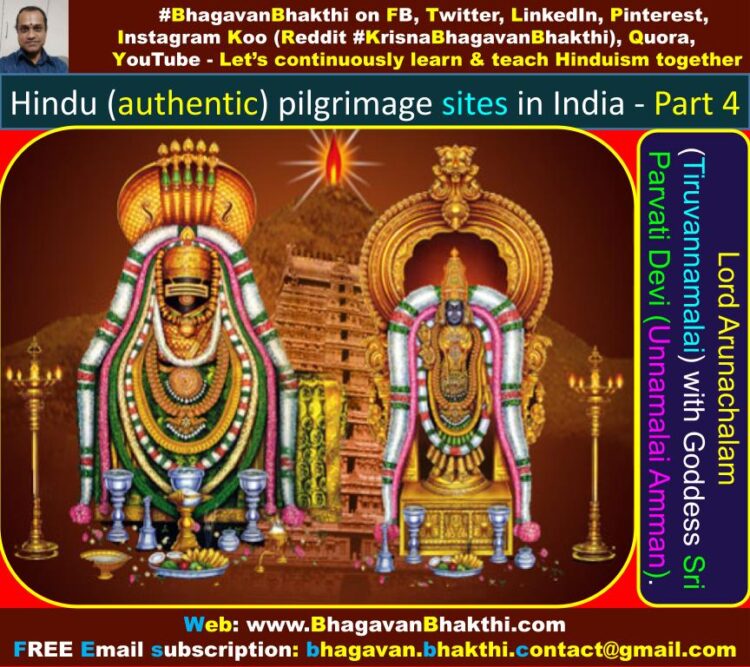
Guru Sri Vadiraja Tirtha eulogizes Lord Arunachalam (Tiruvannamalai) as given below:
फणिगणवरभूषः पार्वतीश्लाघ्यवेषः | खलजनकृतरोषः खण्डितात्मीयदोषः |
सदरुणगिरिवासः शक्रसूर्याद्यधीशः | परिहृतभवपाशः पातुमां पार्वतीशः ||
Meaning of the above shloka : May the Lord of Goddess Sri Parvati Devi (Lord Shiva), someone who wears snakes as precious jewels,
someone whose form is appreciated by Goddess Sri Parvati Devi, someone who gets angry at evil,
someone who removes the faults of his own devotees, someone who is the Lord of Lord Indra, Lord Surya and other Devatas (Demigods),
someone who relieves us from the bondage of Sansar (Samsara) (From birth until death), someone who resides in the excellent aruna (chala) hill, let him protect me!
Arunachalam (Tiruvannamalai) (Arunachalesvara) is situated around 180 kms from Chennai in Tamil Nadu.
It is also known as ‘Arunachala or Arunachaleshwara or Arunachalesvara‘.
The hill itself is believed to be the ‘Agni Tattva Linga‘ of Lord Shiva.
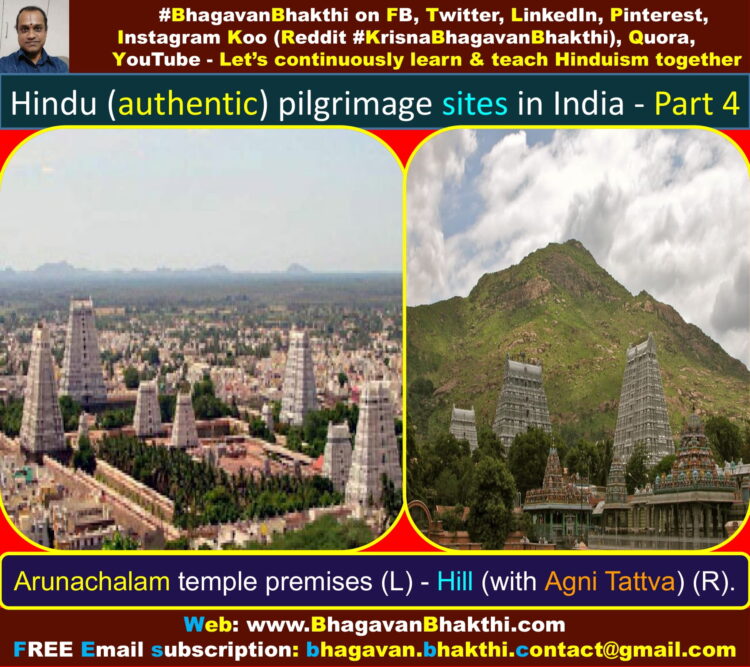
On the occasion of ‘Kartika Purnima‘, a special jyoti (divine light) is lit on top of this hill, and is considered highly auspicious.
Thirukovilur Perumal (Ulagalantha Perumal Temple) : Guru Sri Vadiraja Tirtha explains the avatar of Lord Trivikrama (Lord Vamana).
Tirukovilur town is about 40 kms from Villupuram.
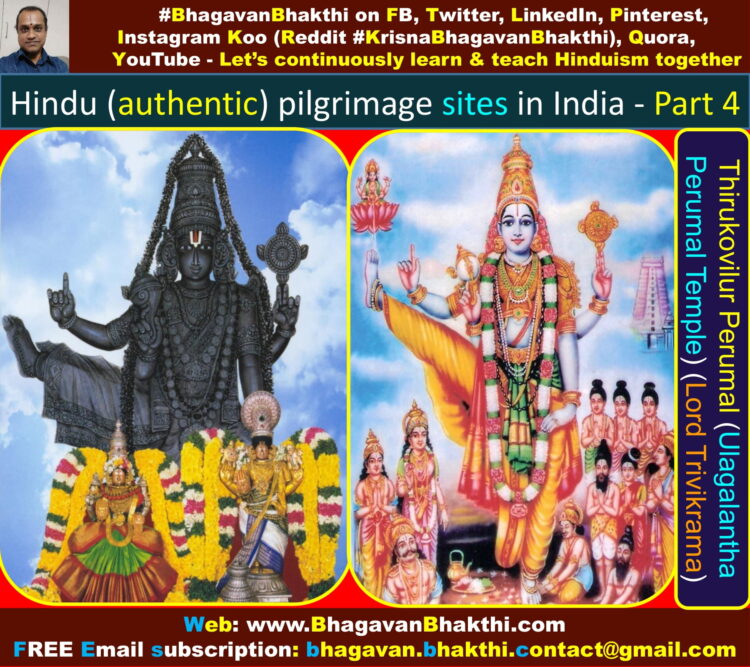
This is one among the “Pancha Krishnaranya Kshetram” (five places of Lord Krishna).
Thirukovilur is a very well known ‘Vaishnava Kshetra‘ and is very close to Tiruvannamalai (Arunachalam).
The Sthala Purana (Local legend) of this place states that –
it was here that Lord Vamana took the Lord Trivikrama form and measured the entire Brahmanda (Universe) with just the edge his foot’s nail.
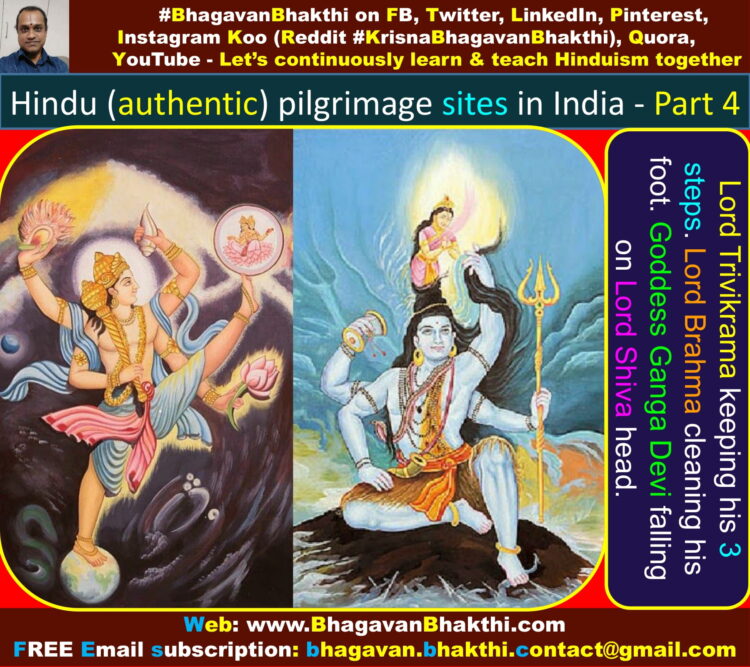
Guru Sri Vadiraja Tirtha glorifies Lord Trivikrama by saying that, his valour is so great that even Lord Aadi Shesha, possessing 1000 heads and thus tongues, cannot finish counting the same.
In Thirukovilur today, there is an huge Lord Trivikrama temple with the deity being at least 10 ft tall.
Brihadisvara (Vriddhalacheswara) : A humongous temple of Lord Shiva (Maheshwara) is located at Thanjavur (Earlier it was called as Vriddhachalam).
Lord Shiva presented himself before a saint called by Vibhishita, pleased by his deep penance.
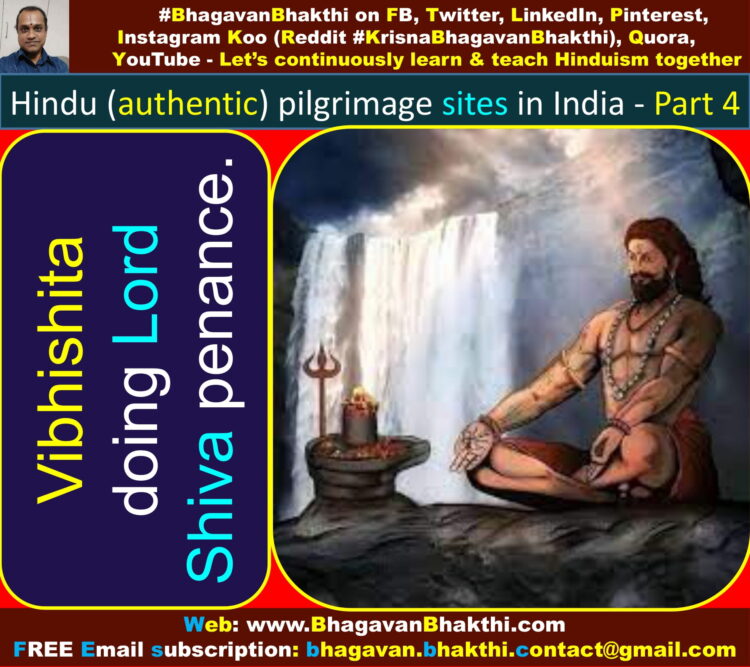
Guru Sri Vadiraja Tirtha eulogizes Lord Shiva of Brihadisvara (Vriddhalacheswara) as given below:
वृद्धाचलकृतावासः सद्योजातस्त्रिलोचनः | अद्यैव ज्ञाननयनं वर्धयत्वचलं मयि ||
Meaning of the above shloka : May the three-eyed sadyojata (Lord Shiva / Trinetra), residing in Vriddhachalam, increase at this very moment, the jnanadrishti in me firmly.
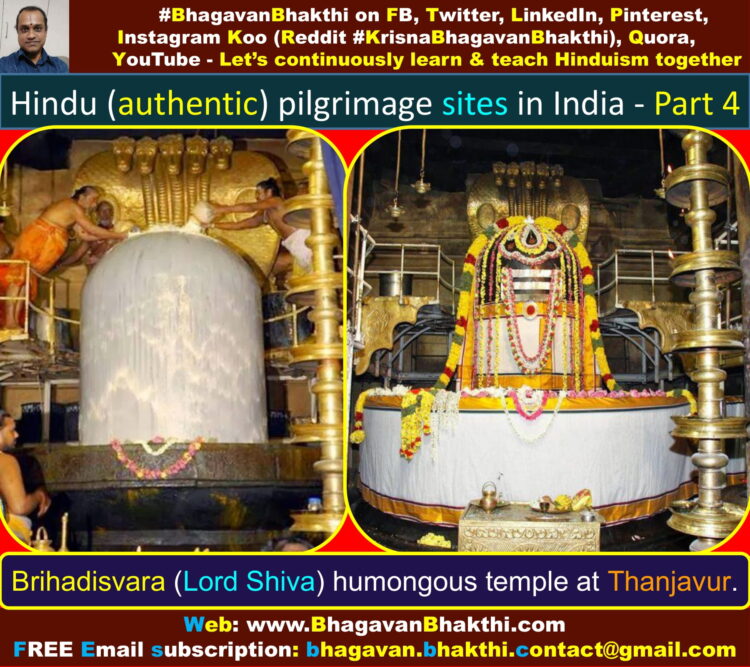
Srimushnam Bhu Varaha Swamy : This auspicious temple is situated about 60 kms away from Thirukovilur.
Lord Vishnu took Lord Varaha avatar in this holy place.
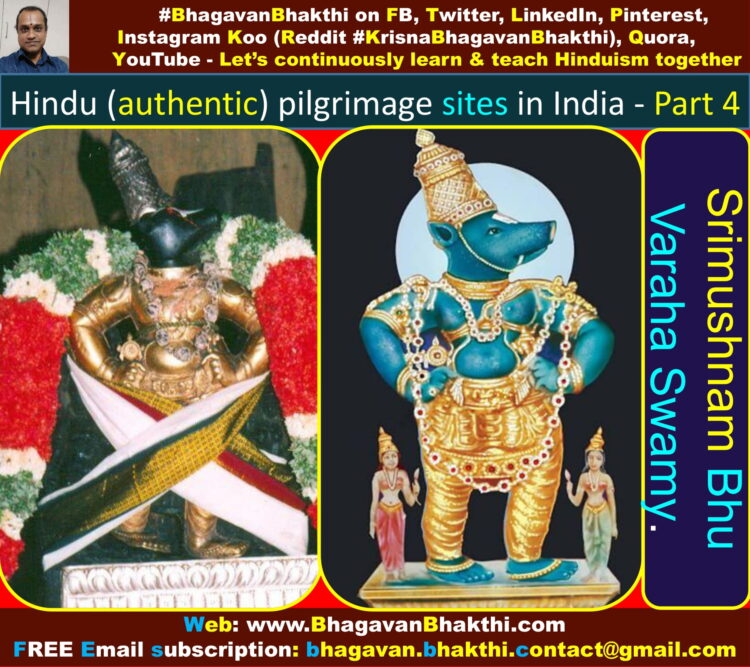
This place Srimushnam is one of the 8 ‘swayam Vyakta Kshetras‘ (self manifested pilgrimage place) in India.
It is situated about 60 kms from Thirukoiluru.
This place is well known as the place where Lord Vishnu took the Lord Varaha avatar to destroy the demon Hiranyaksha.
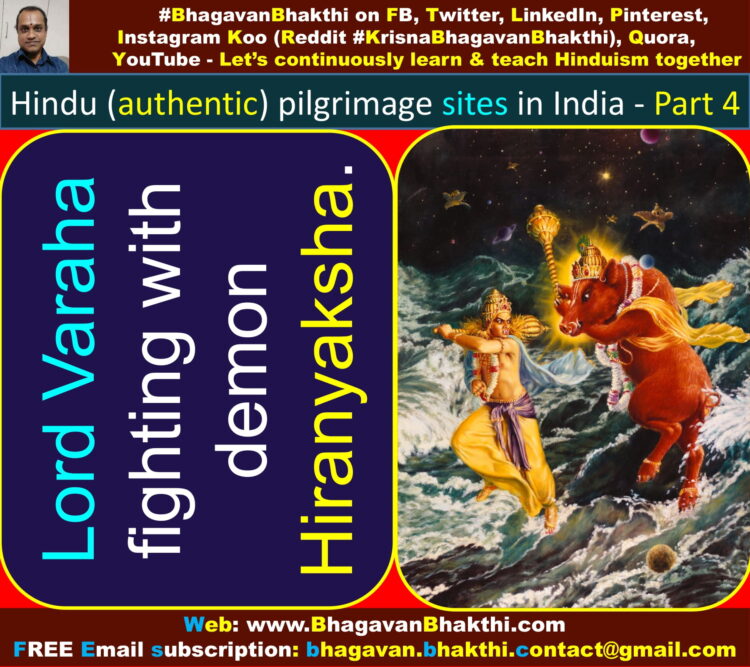
In one of the pillars of the Srimushnam Bhu Varaha Swamy temple, there is a deity of Sri Madhwacharya that has been carved and is worshipped even today.
The great saint Sri Madhwacharya did one ‘chatur masya‘ here.
Sarangapani Kumbakonam (Kumbhakona) : This historic place is located on the banks of river Kaveri.
Kumbakonam is a temple town with large number of temples.
Guru Sri Vadiraja Tirths narrates the glory of Sarangapani (Sharngapani) in this place.
In Tamil Sarangapani is called as Aravamudhan.
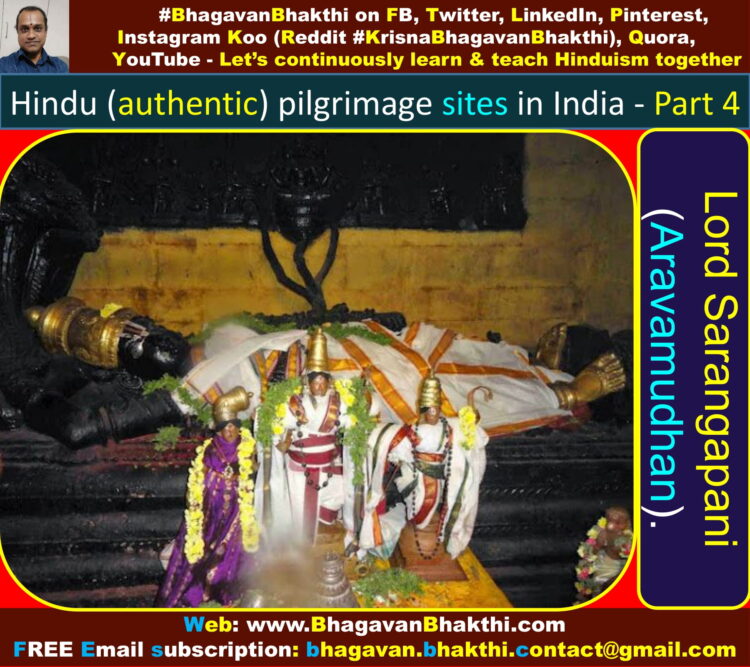
Kumbakonam (Kumbhakona) is one of highly auspicious Tirtha Kshetras (Pilgrimage place) of India.
Kumbakonam is also called as ‘Kamakoshneepura’ in various Hindu Puranas.
The five main temples of Kumbakonam are as given below:
Sharngapani (Aravamudhan),
Kumbheshwara (Adi Kumbeswarar),
Vagheeshwara,
Ramaswamy and
Chakrapani.
The deity of Lord Vishnu which is called as Sharngapani does not really hold the bow.
The Sthala Purana (Local legend) records that, the bow (Saranga) is actually hidden at the base.
Thus ends the Purva Prabanda (India’s East-Southern side pilgrimage sites part 4 information).
To watch videos on #Hinduism #Sanskrit language, SUBSCRIBE to my YouTube channel from this below link:
#BhagavanBhakthi YouTube channel
For “Hindu (authentic) pilgrimage sites in India – Part 1“, please click the below link:
Hindu (authentic) pilgrimage sites in India – Part 1
For “Hindu (authentic) pilgrimage sites in India – Part 2“, please click the below link:
Hindu (authentic) pilgrimage sites in India – Part 2
For “Hindu (authentic) pilgrimage sites in India – Part 3“, please click the below link:
Hindu (authentic) pilgrimage sites in India – Part 3
For “Hindu (authentic) pilgrimage sites in India – Part 5“, please click the below link:
Hindu (authentic) pilgrimage sites in India – Part 5
To know about “Ekadashi unknown facts” and real significances of Ekadashi fasting, kindly click the below link:
To know more about “Lord Krishna unknown facts“, please click the below link:
To know more about “Lord Vishnu unknown facts“, please click the below link:
To know more about “Lord Shiva unknown facts“, please click the below link:
Dear friends, if you need any clarifications about this post, kindly let me know, I will definitely try to answer all of them.
Also your one LIKE, one COMMENT, One Share, one SUBSCRIPTION is highly important.
This will help to know the quality of this content and also it will be helpful to know if any improvements is required for the content.
If you feel this content is useful to you and has helped you to improve your knowledge, kindly share this with your well-wishers.
Because “SHARING MEANS CARING”.
For receive FREE EMAIL SUBSCRIPTION about #BhagavanBhakthi, you can send an email to bhagavan.bhakthi.contact@gmail.com from your email ID.
NAMASTE!
Sri Gurubhyo Namaha
OM NAMO NARAYANAYA
Sri Krishnaarpanamastu
Subscribe / Follow us Share in Social Media
I was very happy to discover this website. I want to to thank you for your time due to this fantastic read!! I definitely liked every little bit of it and i also have you book marked to check out new things on your blog.
I was reading through some of your posts on this site and I conceive this website is real informative! Retain posting.